Thinking of going to Iran but not entirely sure how to start planning? This beautiful country is very much underrated and sadly only on the radar of the more adventurous souls. But don’t worry I have written down the ultimate two-week Iran travel guide and even threw in some practical information about local etiquette, clothes in Iran, and Persian (Iranian) vegetarian food. Hope his article inspires you to go!
Iran is my personal favorite country to visit, both the local hospitality and architecture is astounding. The depth of culture that runs through the veins of every city is such a thing of beauty that it might surprise you to hear tourism in Iran is not omnipresent.
The reason is maddeningly straightforward: Popular media has cast a shadow on Iran and ostracised it as being filled with terrorists and extremists. My family and friends (despite being very open-minded) pleaded with me not to go. Luckily I went anyway and so should you.
Iran is safe, filled with great food and lovely people. Delve into my Iran itinerary and be prepared for the journey of a lifetime.
All prices are in IRR (Iranian Rials) and based upon March 2020 prices.
Please note Iranians will often use Tomans to talk about price and not Rials this can lead to confusion. Just keep in mind that 1 Toman is equal to 10 Rials.
Please note: This post contains affiliate links, meaning I may earn a commission if you make a purchase by clicking a link (at no extra cost to you). Learn more.
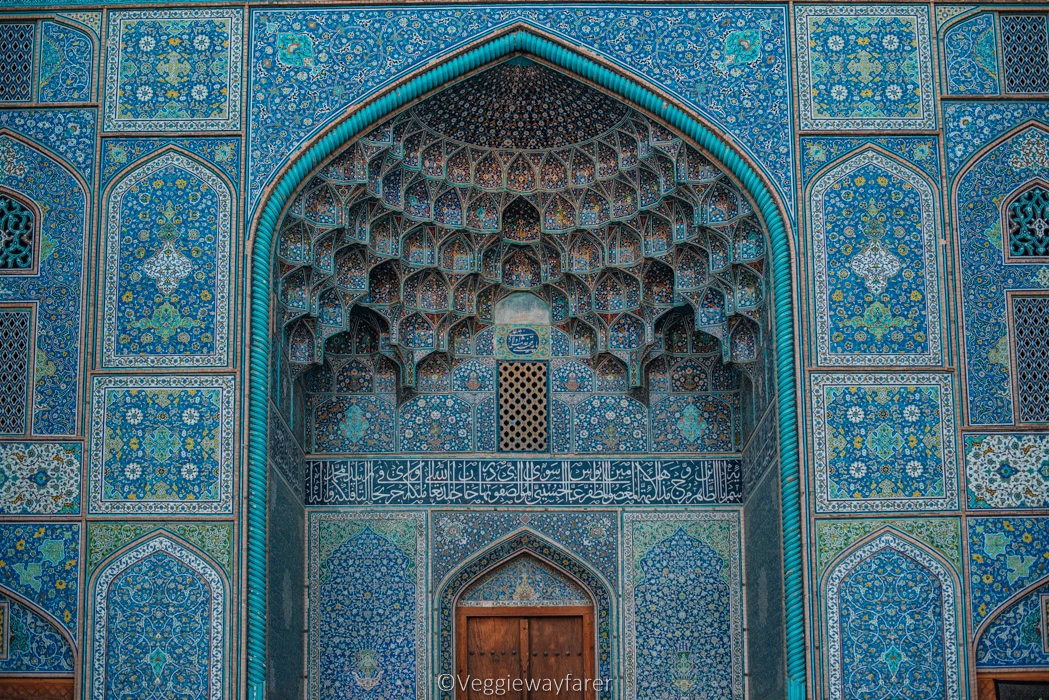
Traveling to Iran: FAQ
Iran (or Persia as it is referred to by some) is a very large country, it’s around 1,648,195 sq. km and has 82 million people living in it. It is in the top 20 largest countries in the world. In short, two weeks is a great start for traveling to Iran but you will be merely skimming the surface of all there is to see and do.
Do they speak English in Iran
The short answer is no. The long answer depends on where you are traveling. In large cities, the younger generation will speak enough English to be able to help you out with any questions you might have.
I got lucky in the sense that my travel bud spoke fluent Persian (Farsi). It made things a lot easier but did not detract from the fact that at times it was hard to understand what was going on. Iranians are some of the most hospitable people you are likely to ever meet this is but one of the reasons to consider traveling or even backpacking through Iran.
Local SimCard
Certain sim cards from abroad are blocked in Iran so your best is to buy a local sim card. You can get them at the airport, right after you pick up your luggage and have cleared customs. There are various companies, but I ended up going with Irancell and pretty much had coverage everywhere.
To get a sim card, you fill out a form pay IRR200.000 and have a copy of your passport taken. The local agent helped me install the sim card and I was good to go for 2 weeks.
Payment inside the country
Credit cards in Iran are blocked. You will not be able to use VISA, MASTERCARD, MAESTRO, or any other foreign supplier. So your best bet is to get in contact with a local company to use a prepaid card. I used the services of Daricpay. The team speaks very good English, is readily available via email or WhatsApp to answer all your questions.
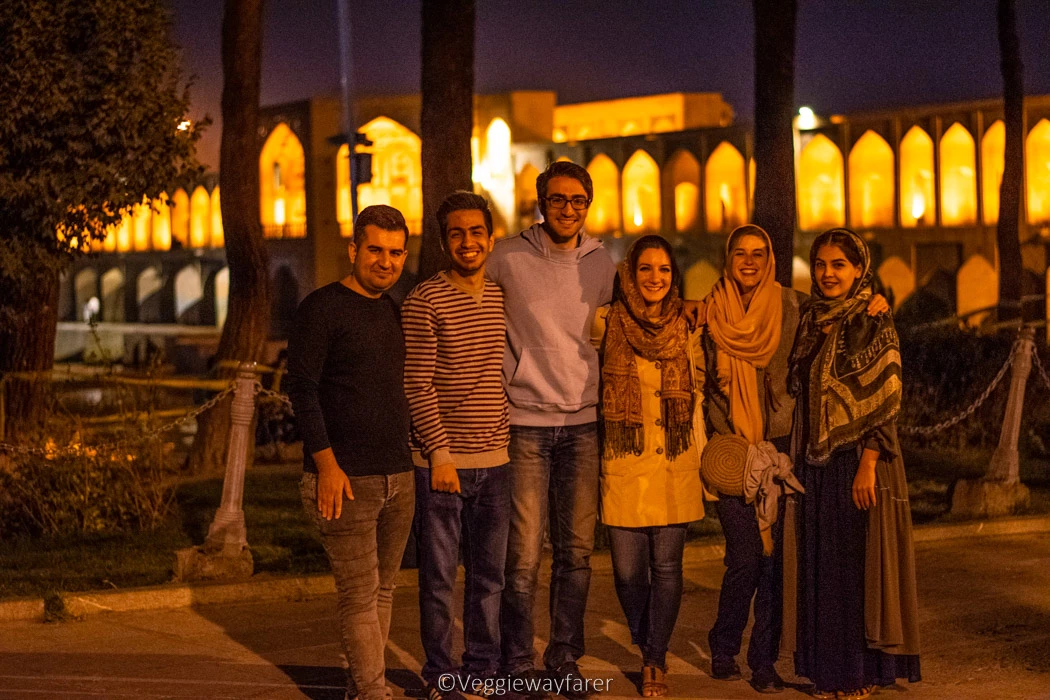
Best way to plan a trip to Iran
We had a lot of help from a local tour agency when planning the trip. They are a team of young guys, with a lot of experience in tourism with a professional yet very fun approach. So much fun, that they ended up becoming close friends that I still talk to on a very regular basis.
I have never overtly promoted any agency on my blog, but will happily do so this time around. If you have any questions about travel to Iran (that are not answered below) be sure to check them out: www.termehtravel.com
Read more Iran guides: If you are traveling through Iran, you might be interested in specific guides to Kashan, Isfahan, and Shiraz.
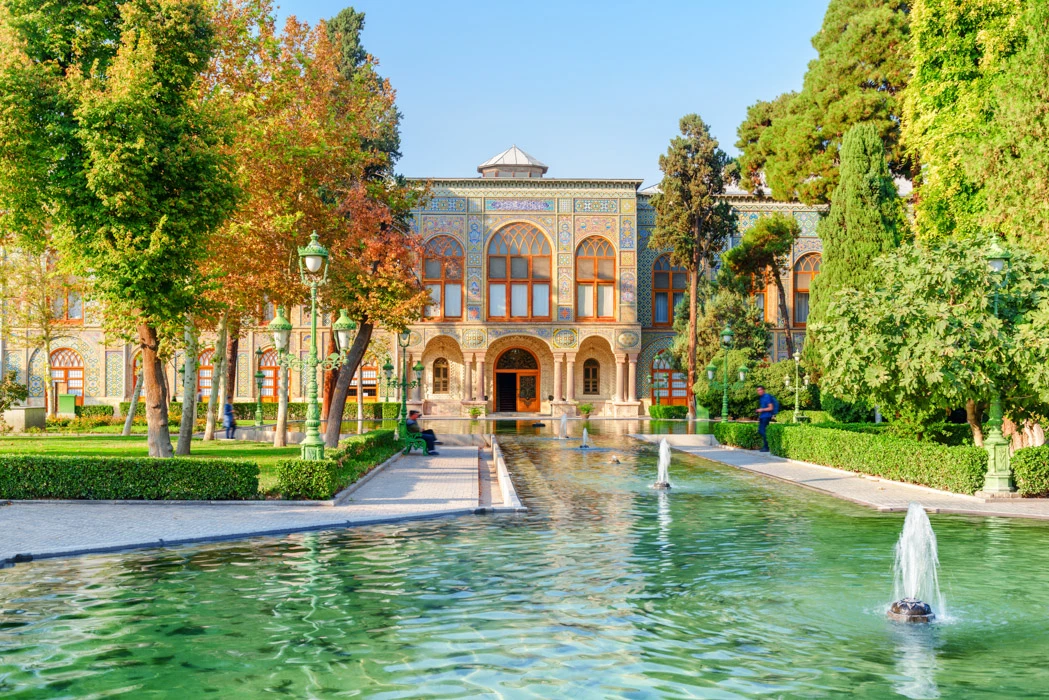
Two week itinerary – Iran
Day one in Iran: Tehran
Tehran is the capital of the country and like every other capital in the world, it is bustling with people on a mission. This translates into horrendous traffic jams and a lot of creative driving skills. After careful consideration, I decided to skip Tehran in favor of a few extra days elsewhere in the country.
If however, you do have a day to spare, be sure to check out the Golestan Palace, the oldest historical building in the city. Next time I am in Tehran, this is going to be my first stop. From all accounts, this palace is a real gem of Qajar architecture with its beautiful gardens, the intricately decorated main hall, and best of all, the room of mirrors.
Practical Information for visiting Golestan Palace:
Entrance fee: IRR2.000.000
How to get there: Very close to two metro stops (15th of Khordad and Imam Khomeini)
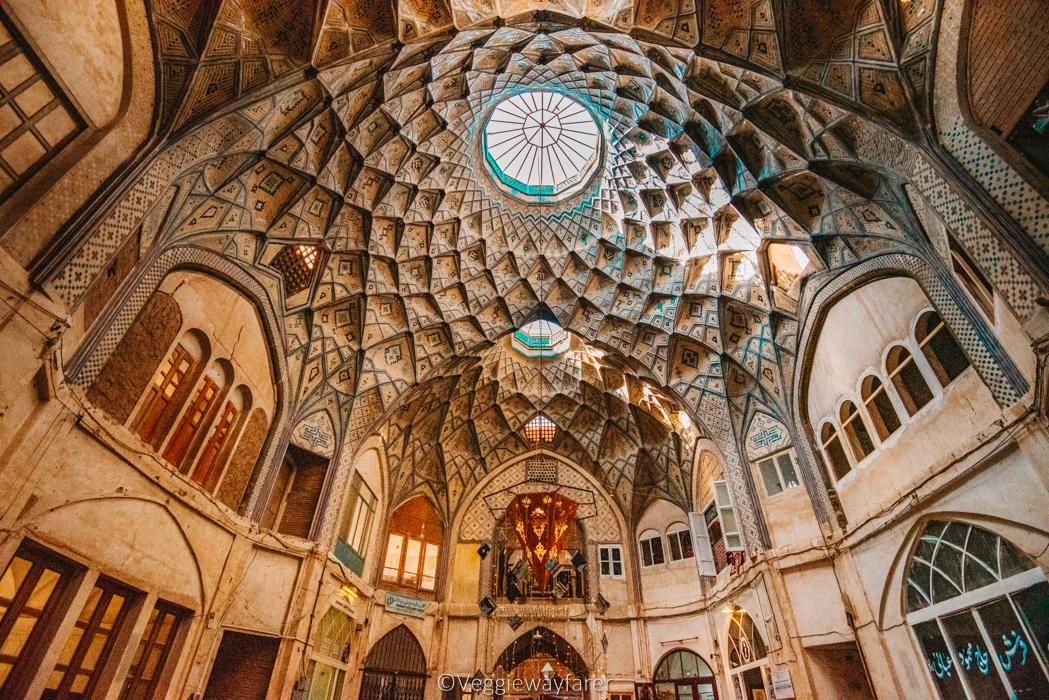
Day two and three in the Iran guide: Kashan
Kashan is a relatively small city and usually, tourists traveling through Iran tend to skip it. If you have the time, my suggestion would be to add it to the itinerary. Kashan is conveniently located between Tehran and Isfahan and is well worth two days of your time.
Good to know is that the city is known for manufacturing carpets. So if you are looking to purchase a beautiful Persian rug, this is the place to do it!
An important thing to note when visiting Kashan is that due to its smaller influx of tourists a foreign face might incite many curious stares. Locals are simply not as used to foreigners as in other larger cities across the country. There is absolutely no need to be scared, people are just naturally curious.
Short on time? Here is a neat overview of all the places to visit in Kashan.
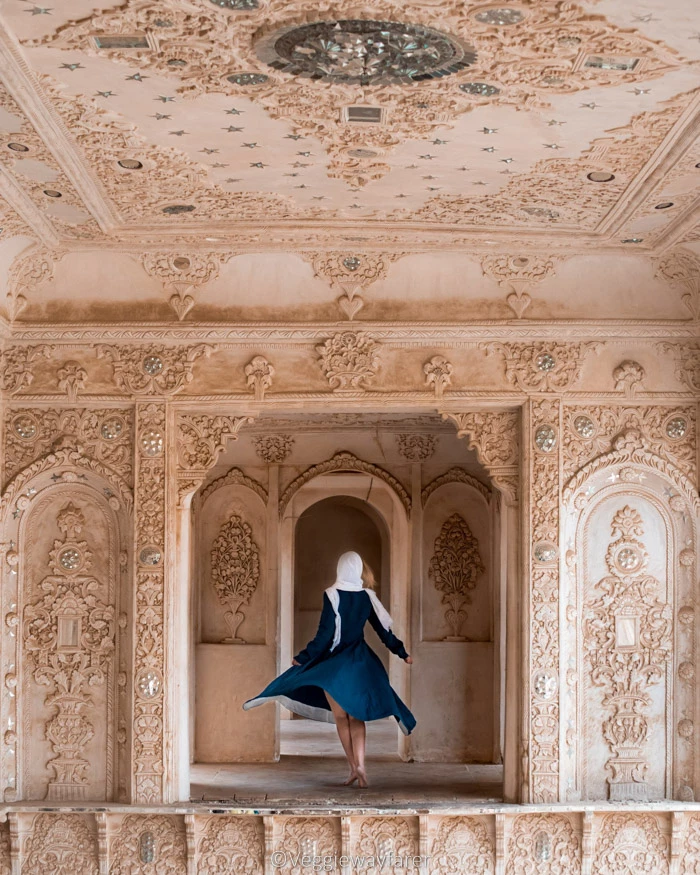

The traditional houses in Kashan
These guys are most definitely one of the main reasons we decided to visit and an important tourist attraction in Kashan. They give you a glimpse into the life of the wealthy Persians in the 18th and 19th Each one is just that little bit different, so make a day out of it and go house hunting. Here is a list of my favorite houses.
- Abbasi house: IRR 150.000
The highlight was the beautiful colourful stained glass.
- Tabatabai House: IRR300.000
A house that was built by the wealthy Tabatabei family, by the same architect who built the Borujerdi house and also the Bazar in Kashan. Think opulent stucco, geometrical gardens and mirrored walls.
- Borujerdi house: IRR300.000
Personally this is my favorite. Built by the husband of the daughter of the Tabatabei family. It took a full 18 years to get this house completely built. The husband wanted the house to be even more splendid than the Tabatabai House (guess what, he succeeded).
- Ameriha House: IRR150.000
Originally built as the house of the Governor of Kashan. The property is absolutely huge and also moonlights as a hotel and teahouse. They have an excellent selection of Persian fresh lemonades which you might want after walking around this huge property. If you do decide to have a drink at the café, or better yet stay at the hotel
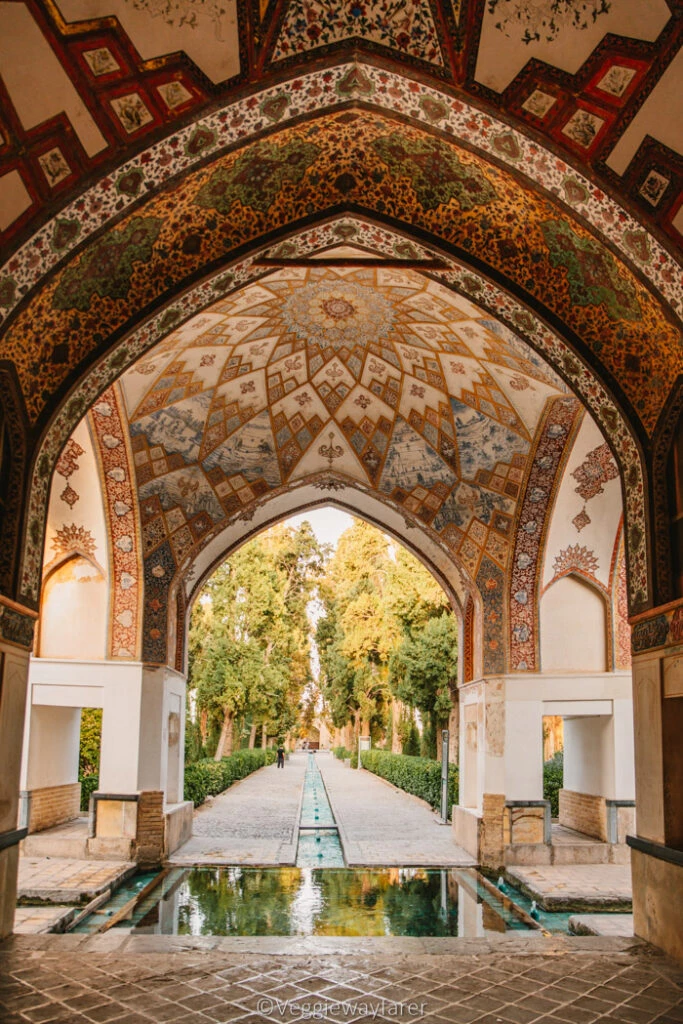

Fin Garden: IRR500.000
One of the oldest gardens in Iran, dating back to the 16th century. It is a perfect example of a beautiful Persian Garden (think water elements, plenty of different trees, and geometrical architecture. The garden is also the site of a murder! Little gruesome but mighty interesting. You can roam around for a good 2 hours.
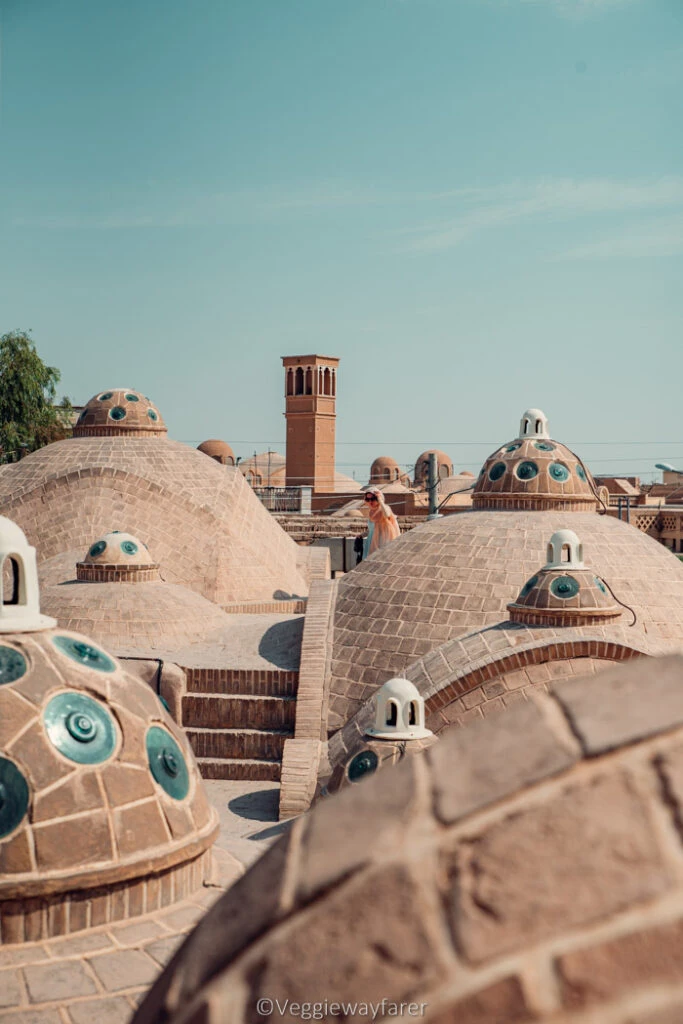

Sultan Amir Ahmad Bathhouse: IRR150.000
Talk about bathing in style, this bathhouse dates back to the 16th century and is a must-see tourist attraction in Kashan. It has beautiful tiles, in deep green and blue tones and wonderful arched ceilings. It is not in use anymore these days, although frankly, I think it would make one hell of a spa area!
Be sure to head up to the roof to see the domes and of course the view over the city. The guards will be a little hesitant to let you take pictures up top, so make sure to tell them in advance.
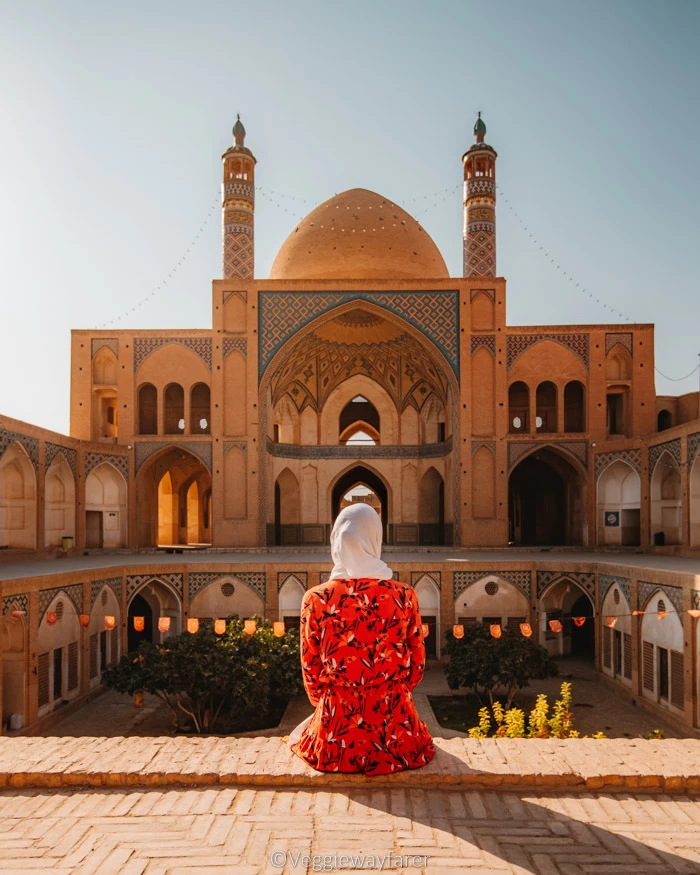

Agha Bozorg Mosque: IRR300.000
A beautiful mosque, that also houses a Madrasa. It is soberer than the mosques you will encounter in Isfahan and Shiraz but definitely worth a visit if you are in Kashan. It is the first mosque in this two-week Iran travel guide and I really hope you do not skip it because of its more sober entrance. Please note, women are required to wear a chador which is available free of charge at the entrance.
Be sure to go early in the morning to avoid the tourists. While there may not be many in Kashan, the tour groups all somehow had this mosque on their morning itinerary.
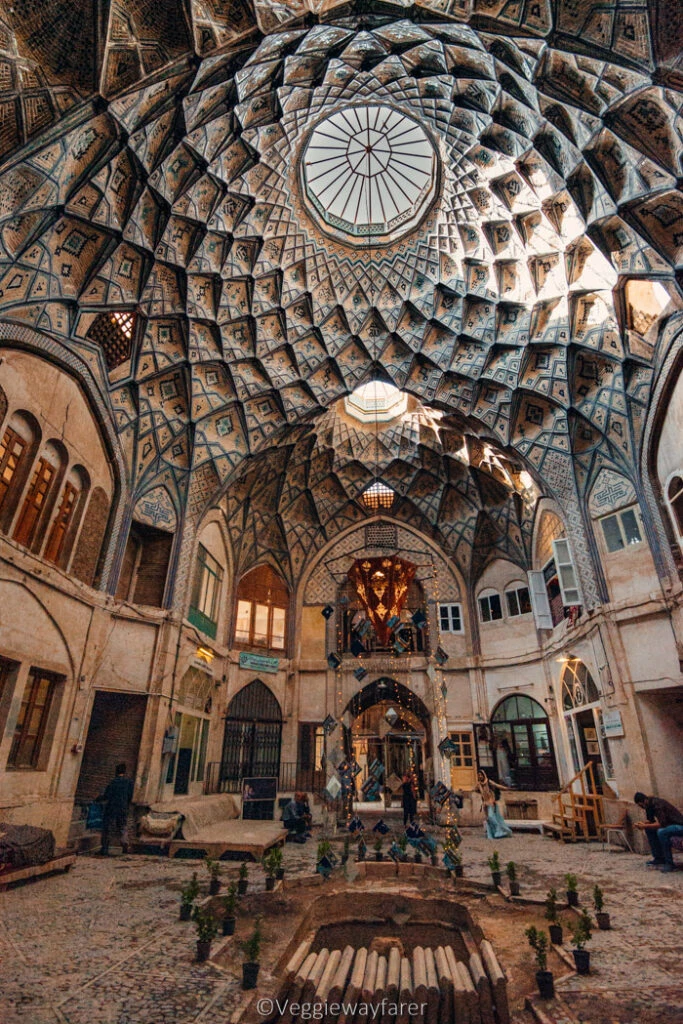

Kashan Bazar: Free
Personally, my favorite part of Kashan was the Bazar! It is still a working Bazar and so it offers a great insight into the daily life of Kashan residents. Older women haggling for a new pair of shoes, or “the guys” hanging out and checking out the ladies passing, you get to see it all.
We were left pretty much to our own devices, there were a lot of curious eyes on us but no aggressive merchants trying to sell us goods. The Bazar has beautiful architecture and little squares tucked away at the end of certain streets. Be sure to head over to the Timche-ye Amin od-Dowleh part of the Bazar to get a cup of black tea and some biscuits. Don’t forget to look up at the domed ceiling.
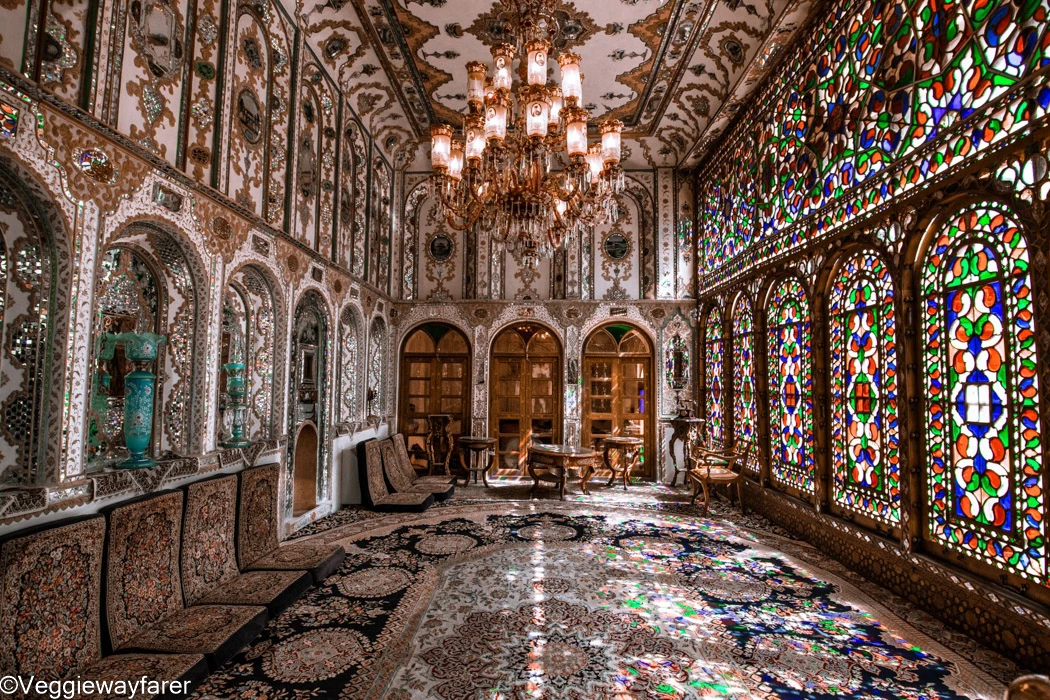
Day four-five-six in the Iran travel guide: Isfahan
Isfahan is the third-largest city in Iran with a population of roughly 2 million. You will need a good two to three days (and a pair of comfy shoes) to see the majority of the sights. The city is known for its grand architecture, most of which dates back to the Safavid dynasty when the city was the capital of the very large Persian Empire.
Isfahan has a long history of welcoming foreigners. It was an important stop on the Silk Route and to this day is one of the most visited cities by foreign tourists traveling to Iran. It’s safe to say locals are accustomed to seeing foreign faces. As far as Iranian cities go, it was one of the most welcoming we encountered and my personal favorite.
Read More: Insider’s guide to Isfahan.
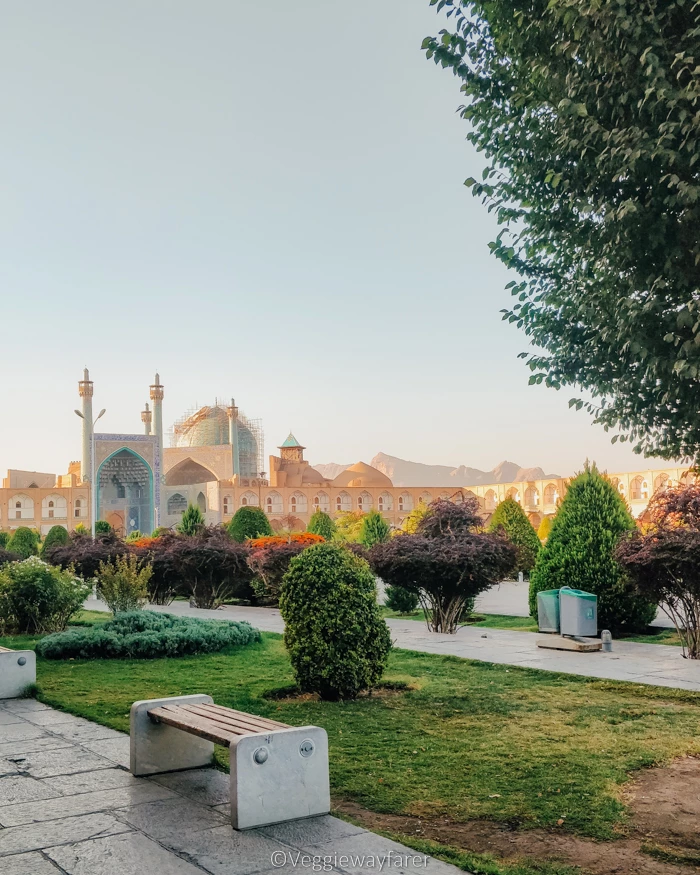

Free Walking Tour Isfahan
If you are not entirely sure where to start, this 2-hour walking tour will guide you through the major tourist attractions in Isfahan. It’s based on tips, the entrance to the monuments is not included. Please note, that you do need to register for the tour and you can do that here.
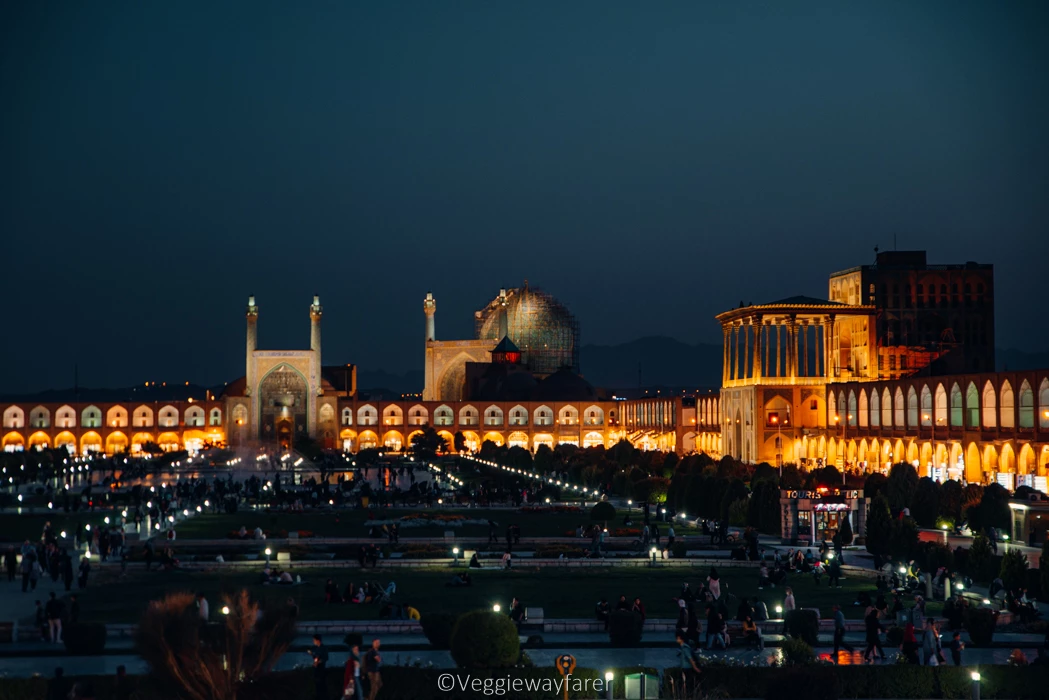
Naghsh – e Jahan Square
The largest square in the world, right after the Tiananmen Square in Beijing. It was built during the Safavid dynasty and houses 3 of the prettiest buildings in Isfahan.
It is absolutely fantastic to visit in the early morning for the best light, the afternoon for the best people-watching and in the evening when you can grab a cup of tea at the Qeysarieh International Museum & Cafe Gallery, which offers spectacular views over the city (for a fee of IRR250.000).
The entrance fee to the café will give you a seat to view the prettiest view we saw while traveling in Iran and will also buy you a cup of tea and some tasty cake.
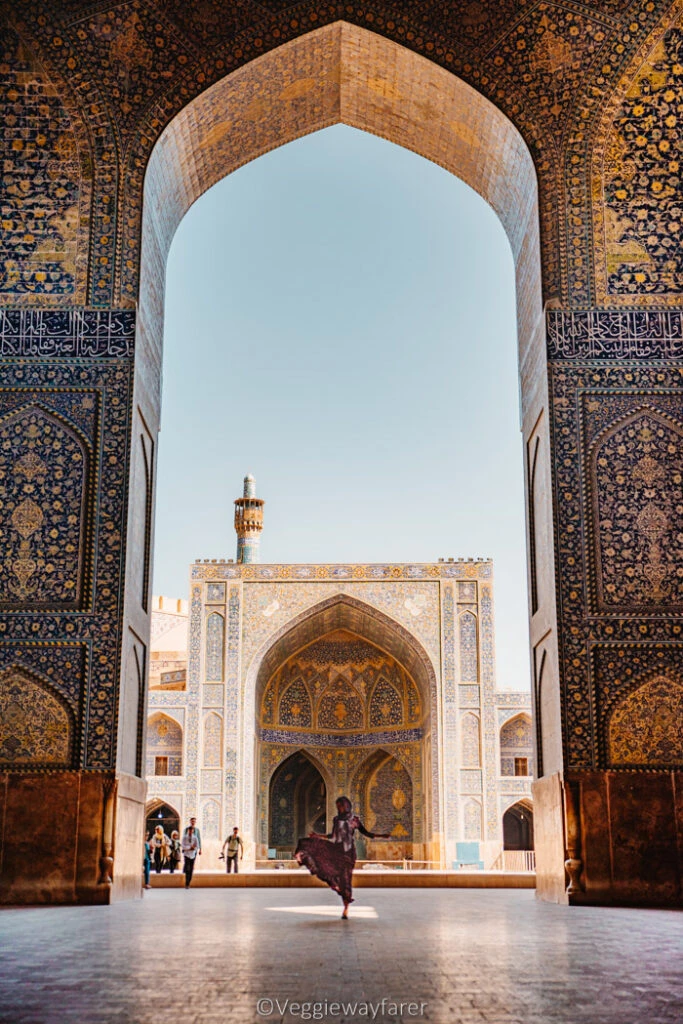

Shah Mosque: IRR500.000
Location on the southern side of the Naghsh – e Jahan Square. This mosque was built for the common people by Shah Abbas I. A perfect example of Safavid architecture, think millions of different types of blue tiles, perfect geometry a myriad of calligraphy, and pretty stalactite-type architecture in the ceilings of the niches.
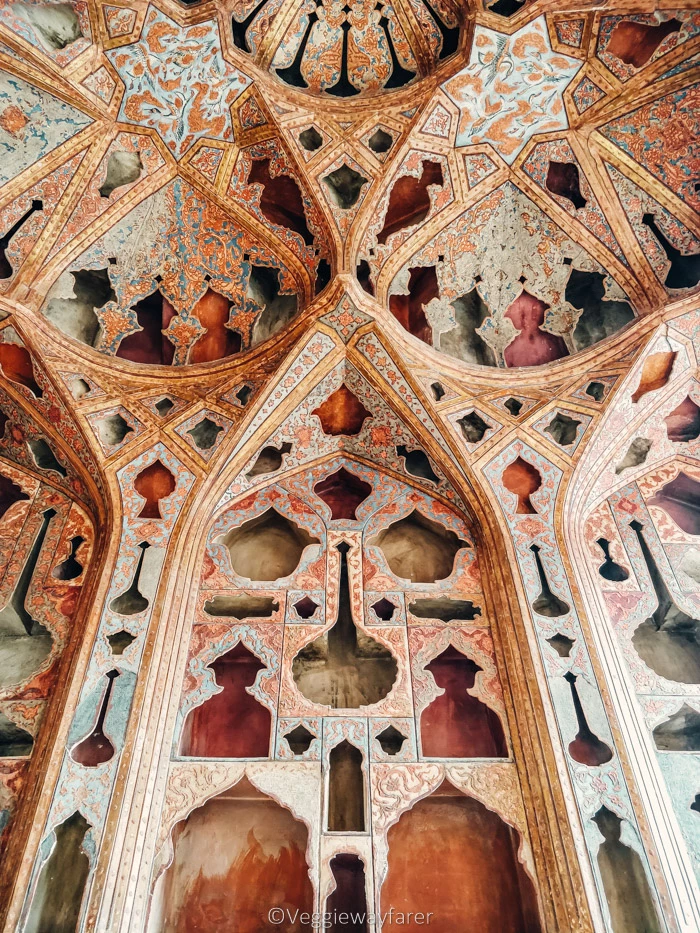

Ali Qapu: IRR500.000
A palace fit for a king, or even a Shah. Ali Qapu was where the Shahs of the Safavid era resided and is located on the western side of the Naghsh – e Jahan square. The Shah had fantastic views over the square, which was reputed to be a great place to play polo or even racehorses.
The real gem of this place is the music room up on the 6th floor. It has beautiful stucco carvings in the ceiling, built to amplify the echo of the musicians playing music.
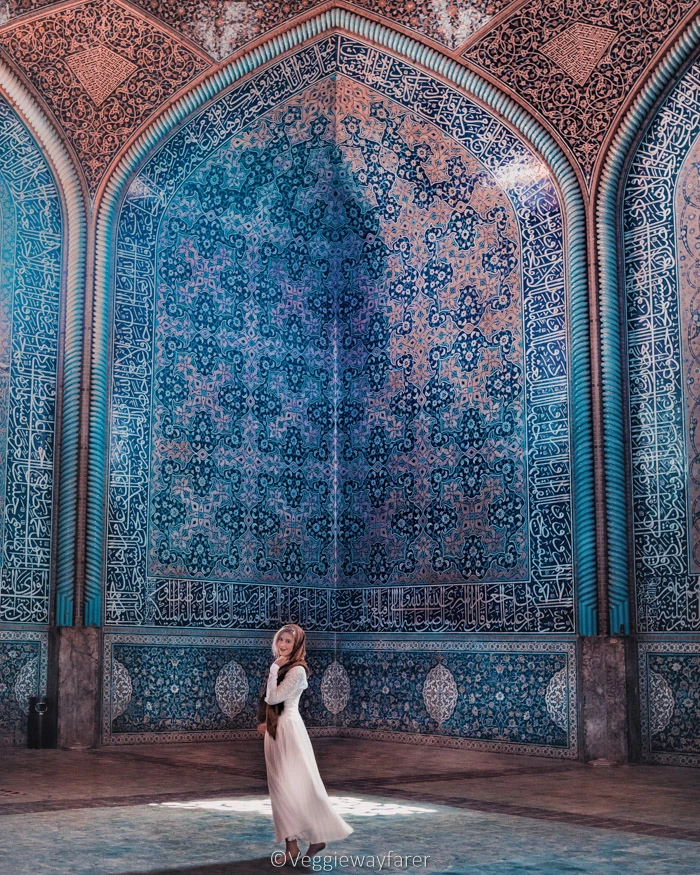

Sheikh Lotfollah Mosque: IRR500.000
Welcome to the private mosque of the Shah and his ladies of the court. The mosque is located right opposite the Ali Qapu palace, on the eastern side of the Naghsh – e Jahan square. While the Shah mosque was open to the public, this ‘little’ mosque was more of a private affair.
What it lacks in grandeur it makes up in intricate details. Walk in, and make a beeline for the main prayer hall. Whatever you do, do not forget to look up and see if you can spot the peacock on the ceiling.
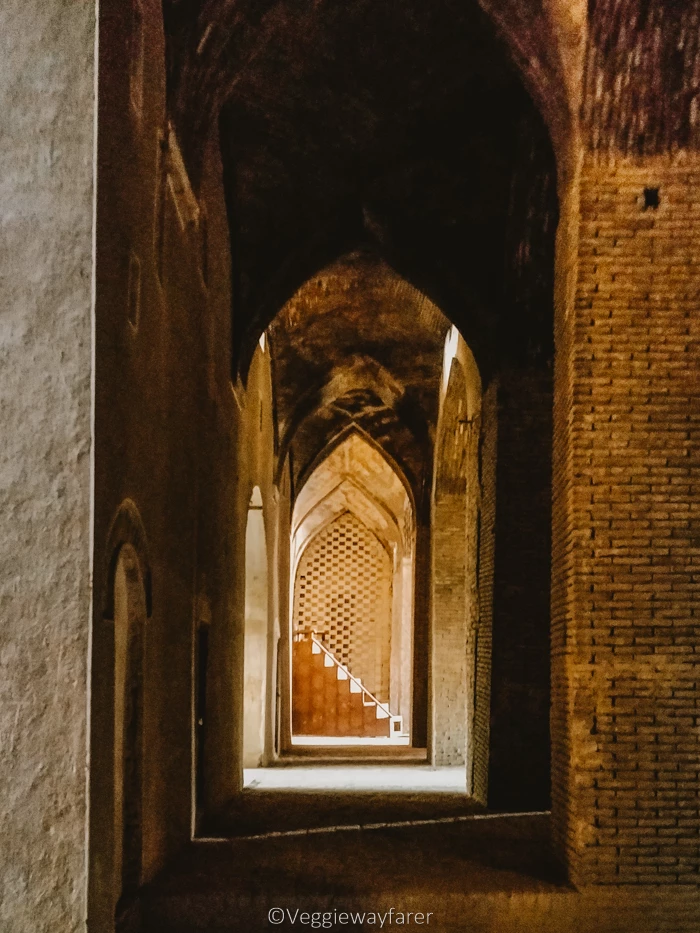

Jameh Mosque of Isfahan: IRR500.000
The oldest mosque in Isfahan dates back to the 8th century BC. Over the years, a variety of different elements were added making it the most eclectic mosque in Isfahan. It was replaced as the main mosque of Isfahan by the Shah mosque in the 17th century.
Jameh Mosque may not look as beautiful on the outside as the more recent mosques, and for some reason, this seemed to make the mosque less of a ‘must-see’ tourist attraction in Isfahan. This was clear by the lack of people when we visited. Give this a place chance and be sure to explore, because behind each door you may find a different type of architecture.
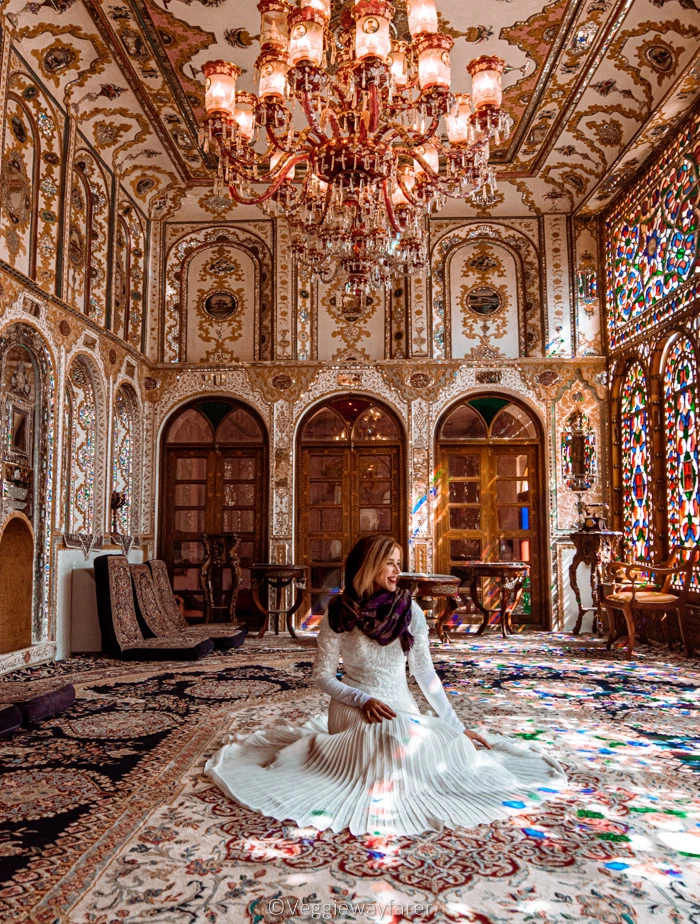

Motamedi (Mollabashi) historical house: IRR155.000
The Mollabashi house is a traditional house in downtown Isfahan. Like the traditional houses in Kashan, it is a beautiful display of the lifestyle of the rich and famous during their day. The house carries the name of one of its former owners, Mollabashi, who was a famous astronomer to the Shah in the 19th century.
Be sure to check out the alcove in the courtyard, and watch as the sun streams in through the stained glass windows and bounces off the intricate mirrored tiles on the opposite wall. Aside from the pink mosque in Shiraz this house probably had the best stained glass windows I saw while traveling in Iran.
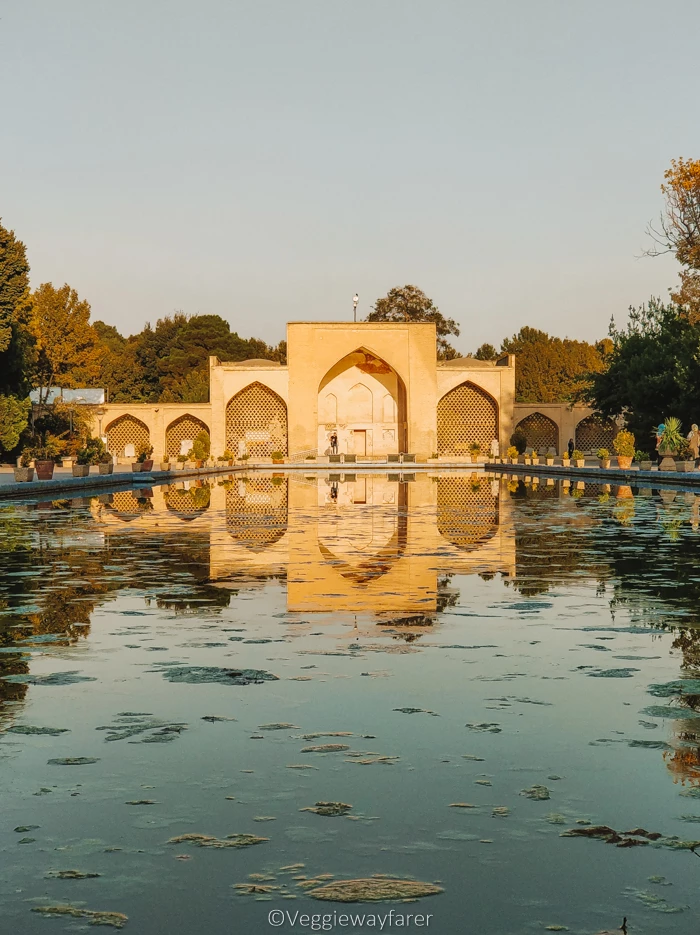

Chehal Sotoon palace: IRR500.000
A palace fit to entertain guests and that is exactly what this palace was built for. It has a beautiful porch which is supported by 20 wooden columns. These columns reflect in the lake, giving the illusion of a forest of 40 columns. That is exactly the secret of the name of this palace (translated as “The palace of 40 columns”).
Chehal Sotoon is decorated with many different paintings, designed to impress the viewer and to demonstrate the power of the Safavid dynasty (think bloody war scenes on wall-size canvases). If you need a bit of mental rest after all those bloody scenes, make sure to have a walk in the beautiful gardens. They are UNESCO classified as a traditional Persian Garden.
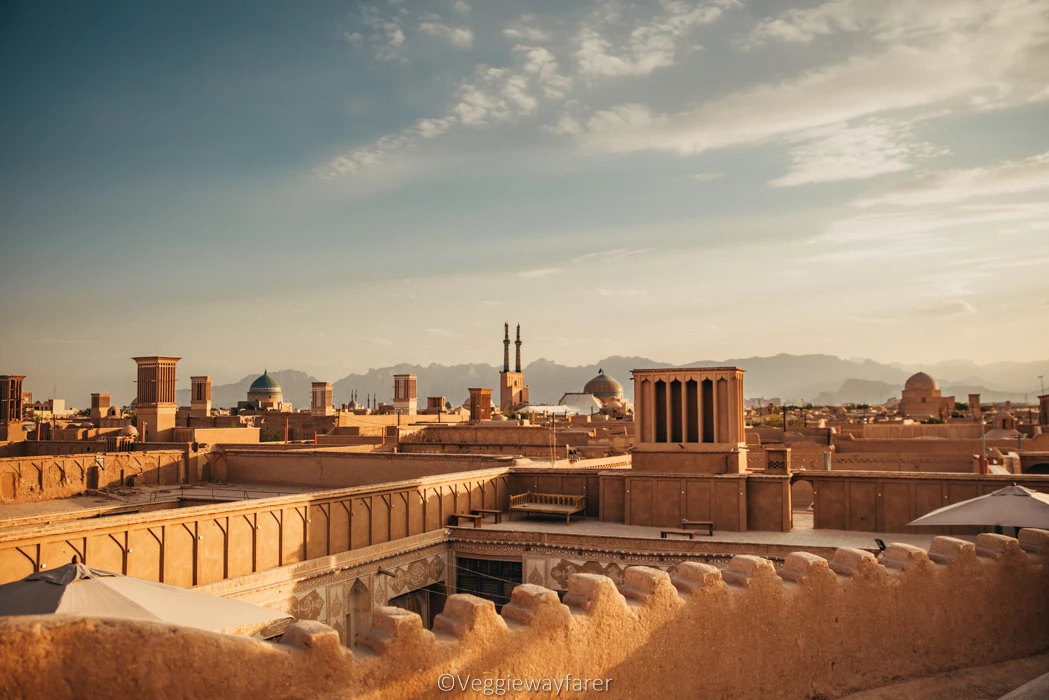
Day seven-eight in the Iran travel guide: Yazd
Yazd is located smack in the middle of the desert, a little oasis with very high temperatures (upwards of 40 C in the summer). The city is known for its wind catchers (Bâdgir) and also for its large amount of Zoroastrians.
As the name wind catcher would suggest, they were built to catch the wind and provide a refreshing breeze to the houses – a traditional form of air conditioning. The wind catchers and the basements are typical architectural features you will find in most of the mudbrick houses dotted across the old town of Yazd (the new town uses modern-day air conditioning)
The city houses some of the friendliest people in the country, who were all very discreet yet curious to know more about us. The friendly nature of the people makes this city one of the top places to visit in Iran for me personally.
Read More: Discover 2-days in Yazd
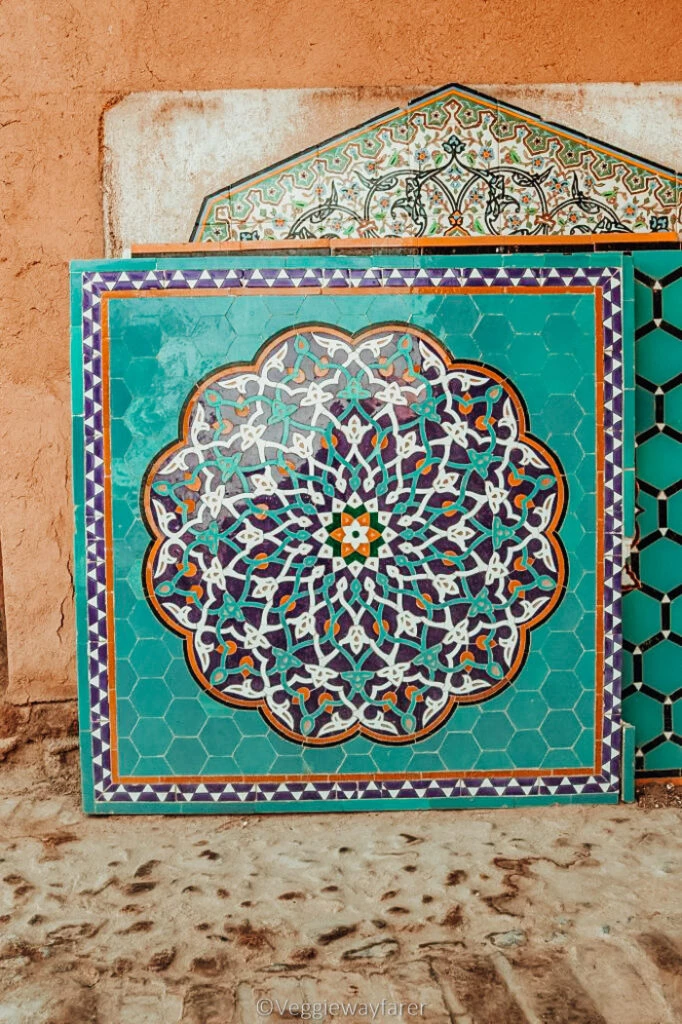

Walk around old town Yazd
The old town of Yazd is a virtual maze of little streets, that look very similar. Google maps will provide some help, although it tends to get lost too now and then. If you are like me and have a knack for getting lost anywhere (despite Google Maps) you might want to do look into a free walking tour that is offered in Yazd.
You will need to register for the free walking tour, however, the fee you pay is totally up to you. It lasts about two hours and takes you around all the important sites of the city. Check it out here.
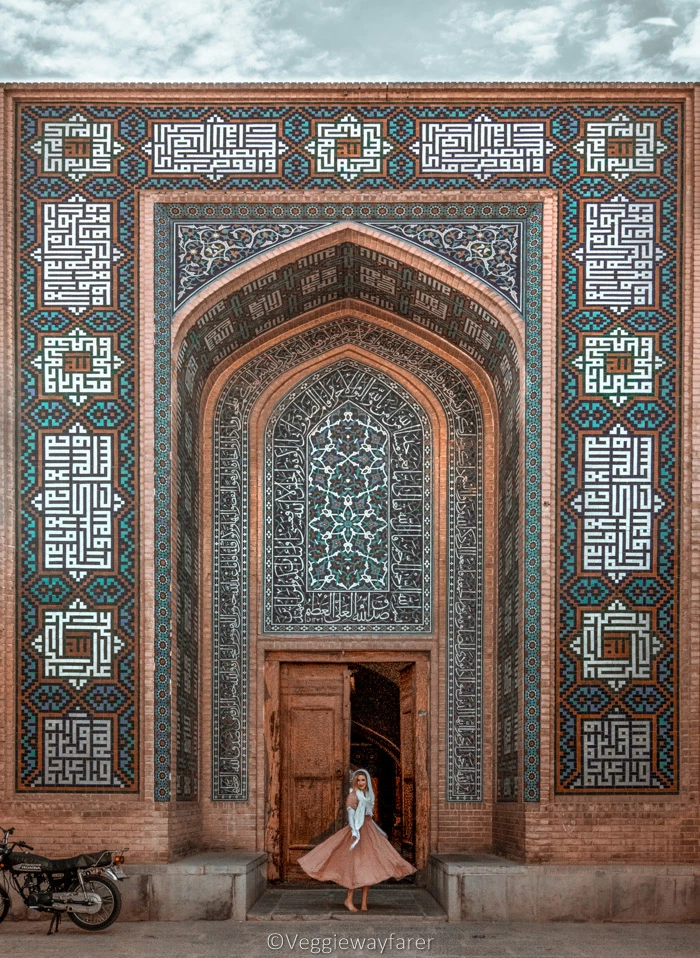

Jameh Mosque Yazd: IRR80.000
This mosque was built on the site of an old Zoroastrian Fire Temple and dates back to the 12th century. Notice the beautiful colored tiles. Remember the dark blue tiles of Isfahan? Yazd has a specific color of tiles, typical for the city. They use many shades of turquoise and yellow to decorate them. The mosque has two huge minarets to mark the entrance.
It is still a working mosque, so please be respectful of the hours for prayer when visiting. The sunrise was absolutely stunning and turned the turquoise tiles a light shade of orange. We ended up walking around to the side entrance to catch a glimpse of the beautiful door pictured below.
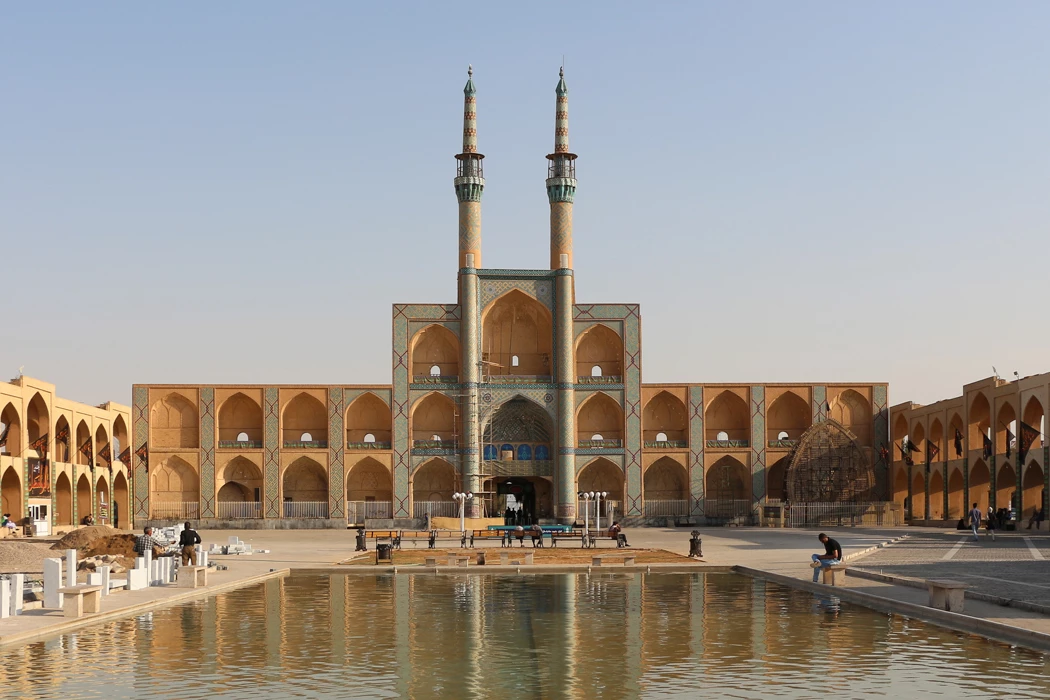
Amir Chakmaq Complex: IRR200.000
We were in Yazd during a religious festival and the mosque and complex were sadly closed. The outside looked absolutely spectacular though, so make sure to visit if you can. The complex contains various buildings (Mosque, Bazaar, Mausoleum, and Bathhouse to name a few).
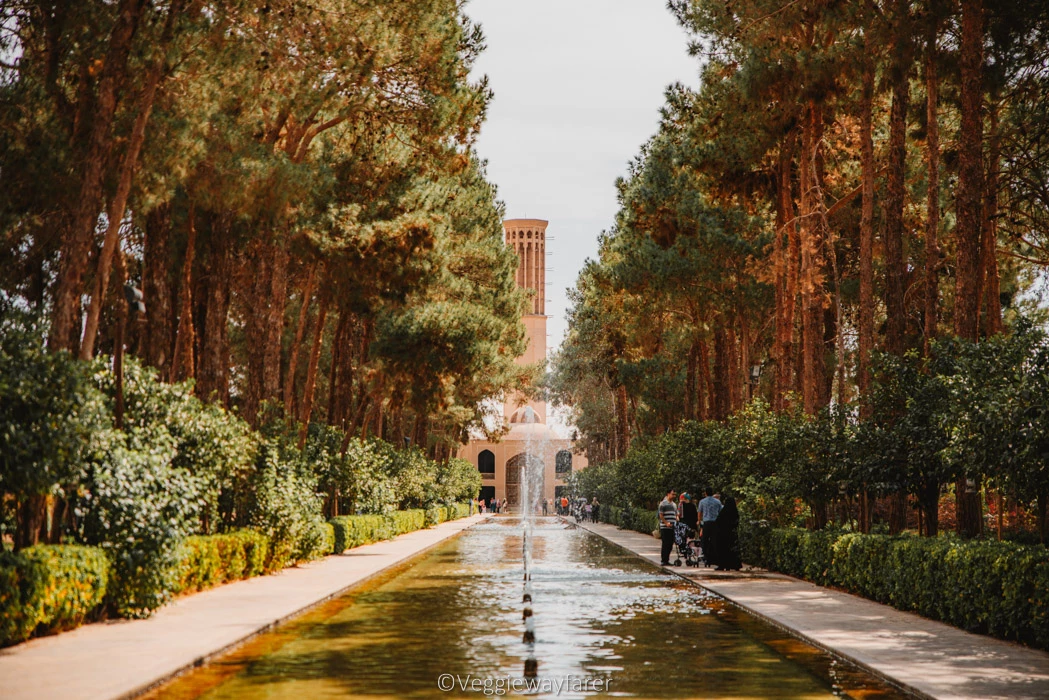
Bagh e Dolat Abad Yazd: IRR500.000
Once the private home of the Shah Karim Khan Zand. It was built in the 18th century and nestled amidst a beautiful UNESCO classified Persian Garden. A cool feature is the Bâdgir which measures 33 meters, and that’s not all – You can actually go inside and walk underneath it! The gardens have water elements and so many pomegranate and sour orange trees.
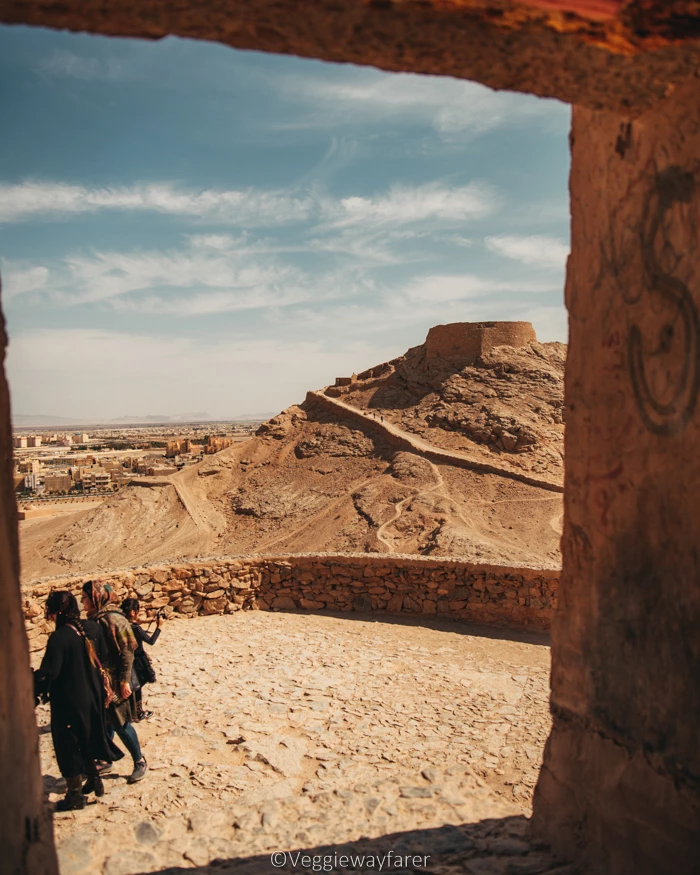

Zoroastrian Towers of Silence: IRR80.000
This ancient burial ground was still used up until the 1970s. The Zoroastrians believe that once the body dies, it becomes impure and there is a risk of it being inhabited by demons. To avoid this happening, the dead would be buried outside the city walls according to very specific rituals.
Bodies were carried up to the hill, placed in a circle exposed to the elements. Whatever remained of the bodies, was then burned and buried. A little morbid, but a place to visit in Iran as you will not find it anywhere else in the world.
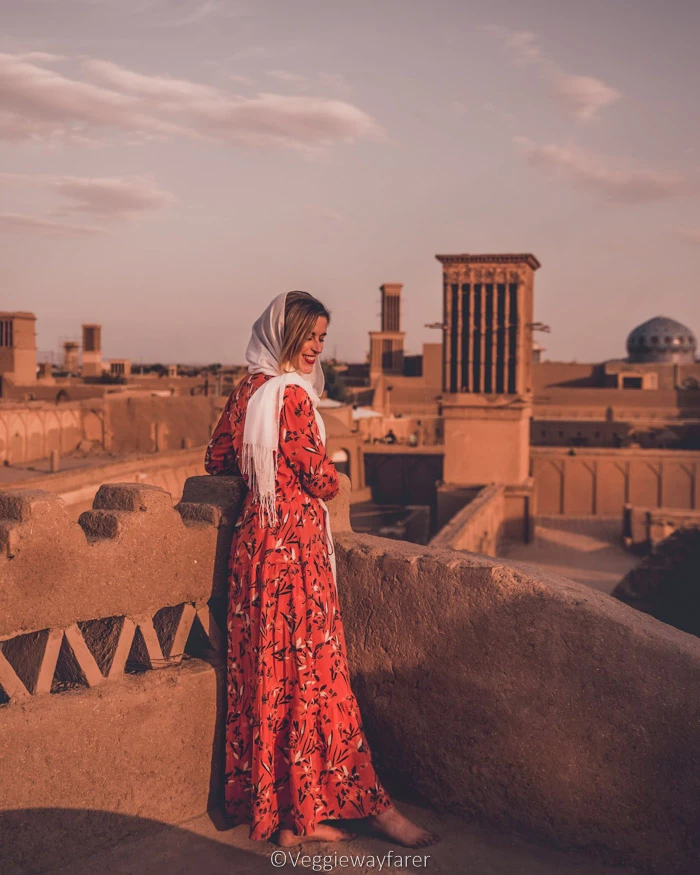

Watch the sunset over the bâdgirs at the Yazd Art Cafe
The best spot in the city to watch the sun go down, and to sip a delicious sekanjibin. The Yazd Art Cafe has a fantastic rooftop that offers panoramic views over the city and its many bâdgirs. It does get pretty busy though so try and go a little in advance.
They offer some delicious food after the sun has gone down sit down and have a nice spot for dinner. The building houses a store with traditional crafts on the ground floor which is well worth a little browse if you have time.
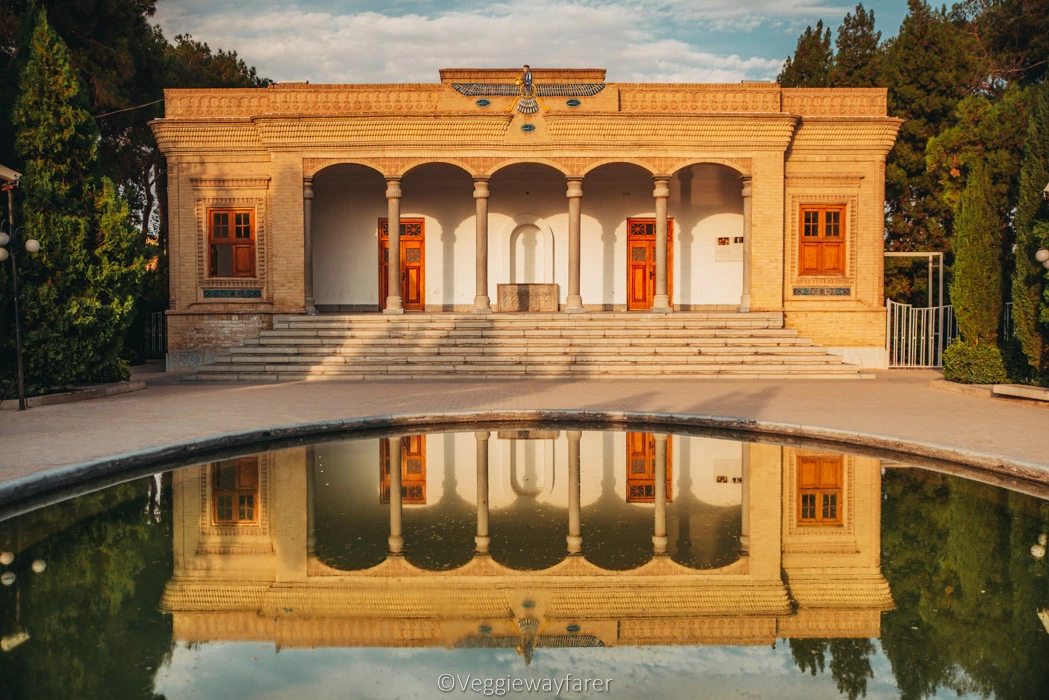
Atashkadeh or Yazd Atash Behram: IRR150.000
Your very first Zoroastrian fire temple. It houses the Atash Behram, which means the victorious fire, and according to various sources, the fire in this temple has been burning since 470 AD. One of the longest-burning fires in the world! The temple contains a museum, which explains the Zoroastrian religion and some of their rituals.
This is the place to go to learn about this ancient religion and a must amongst the list of places to visit in Iran because yet again it really is unique.
Daytrip outside of Yazd – Zein-O-Din Caravanserai
One of the prettiest Caravanserai we visited. It is a little out of town so you might need to order a taxi to get there. Alternatively, you can spend the night here because it doubles as a hotel
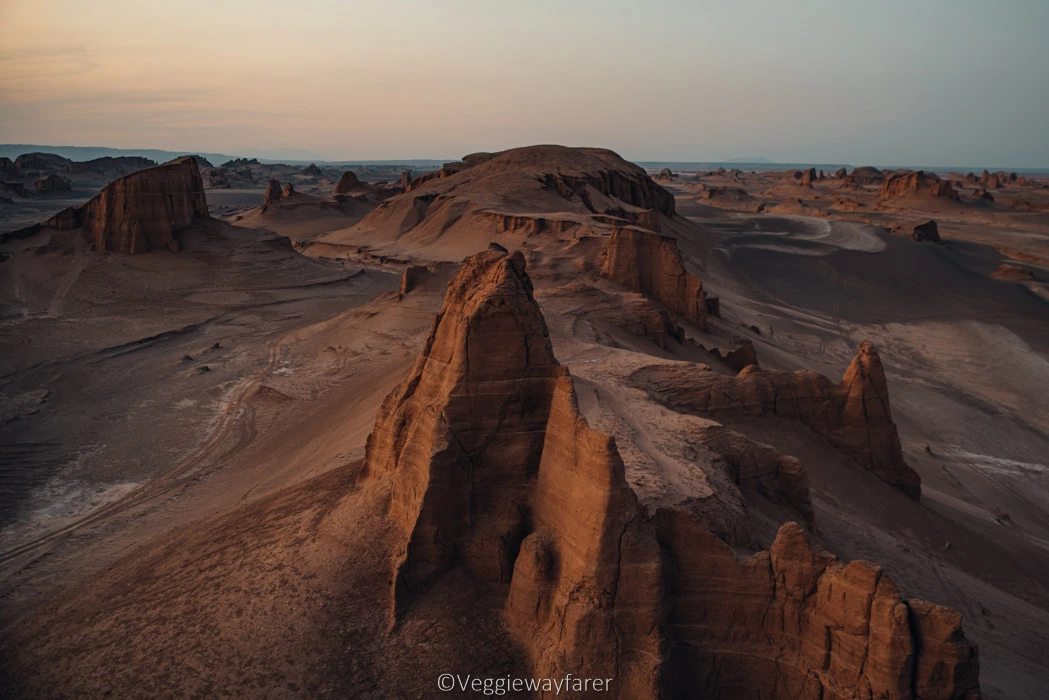
Day nine-ten in the Iran travel guide: Dash-te-Lut Desert
Time to kick off your shoes and enjoy nature’s finest with a tour in the desert. This was one of my favorite places on our Iran itinerary. It is not just any dessert, oh no it’s a UNESCO-classified desert. This desert has been classified based upon a few criteria: The world’s hottest land surface temperatures were recorded here, a whopping 70,7 C if you please
The second reason why this desert has been classified is the wide variety of landforms that can be found in the desert: salt flats, active dunes as high as 475meters, kaluts (the peeks of formations that are entirely made out of sand stuck together) that reach up to 155m high and span for a good 40 km.
We did a 2-day tour, starting with a pickup in Kerman. Our guide, Mansour, picked us up at the hotel, and off we went! We drove to the outskirts of the desert and stopped in a little village. We met up with our driver (Ali) and all four of us piled into his 4×4 – which had been packed with tents, food, and supplies for 2 days in the desert.
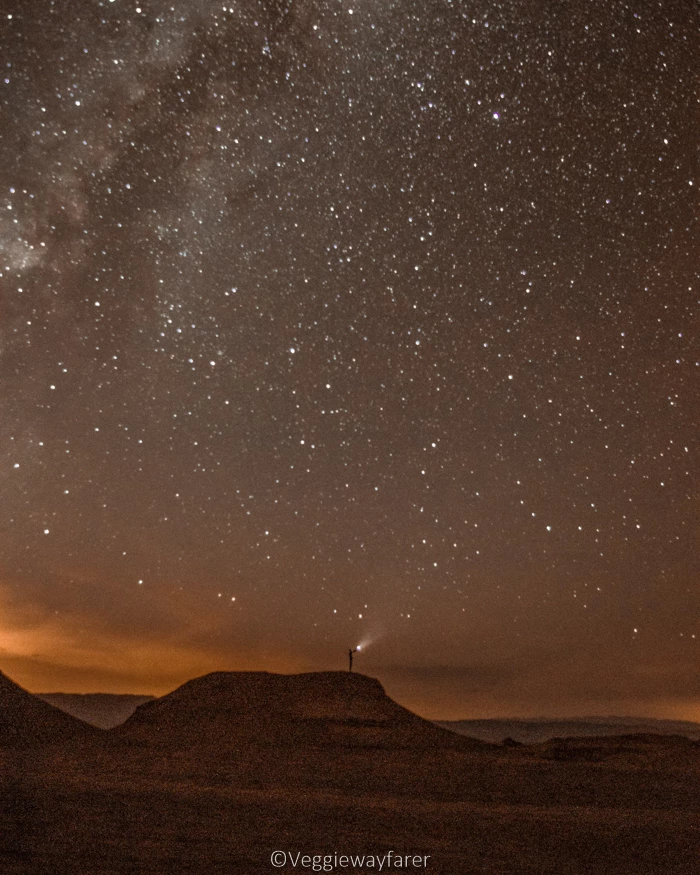

Our guide Mansour spoke fluent English and explained the origins of the desert, and the various different formations (Kaluts) that can be found. As dusk started to set in, we found a spot to watch the sun go down and from which we could take some shots of the stars. There is nothing like watching the stars in a place that is completely quiet and void of all light. We got lucky, the sky cleared up and we got a view of the elusive Milky Way. It was pure magic.
The night just got better after a wonderful dinner of grilled skewers over a homemade fire, and a hot cup of black tea. We looked up and were met by millions of stars and a red moon. A phenomenon which takes place for only a few weeks a year in this region of the world.
After breakfast, we cruised around the dunes and the various parts of the desert. Our driver obviously knew both the desert and his car very well. Up and down the dunes we went, giggling and screaming like little girls.
Practical Information for an Excursion to the Dash-te-Lut Desert
Do I need a tour to explore the desert: You can explore on your own, however, due to the size of the desert it is strongly advised to take a local guide.
Fee: IRR8.00.000 and 25.000.000 per person, depending on how large your group is.
How to book: We booked directly via our local tourist agency
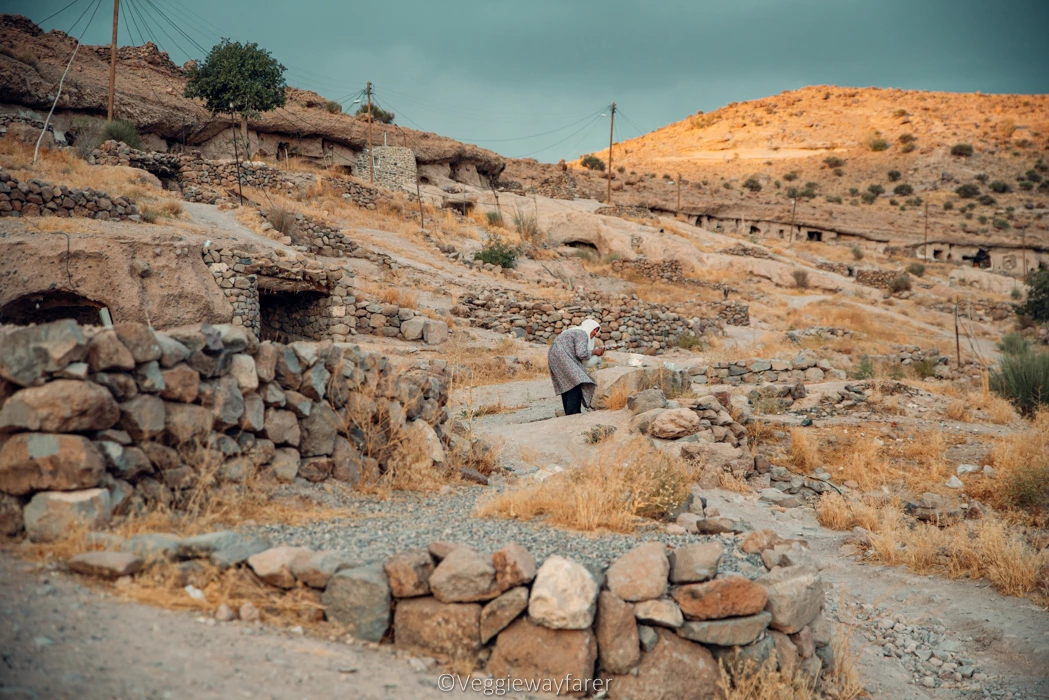
Day eleven in the Iran travel guide: Maymand
This is the smallest and most peculiar village of this Iran travel guide. According to the locals, the village has about 100 people living in it and most of them are of a certain age. So why add this to the list of things to see in Iran? Well, there really is no place in the world like Maymand.
This village has remnants of civilization dating back 12.000 years. And if that does not convince you, the 350 caves that were dug out by hand and where people live ( to this day) might just do the trick. You will be hard-pressed to find concrete or even brick buildings that serve as homes. People are still living in the comfort of their caves, as was the case 3000 years ago.
Granted, they made a few upgrades like electricity, running water, and Wi-Fi but the overall structure is the same. This is one of the reasons why Maymand is classified as a world heritage site.
There are a variety of different walking routes that take you around the village and to the plateaus with great viewpoints. Make sure to ask your accommodation for all the information. We had a really great time sleeping with a local family that runs an Eco lodge.
Maymand is located between Kerman and Shiraz and a great pitstop if you are doing a road trip through this part of the country. So if you have the time while traveling through Iran, try and spend a few days here.
Practical details for visiting Maymand
How to get there: It is about a 3-hour drive from Kerman
Where to stay: Maymand and Moon Ecolodge
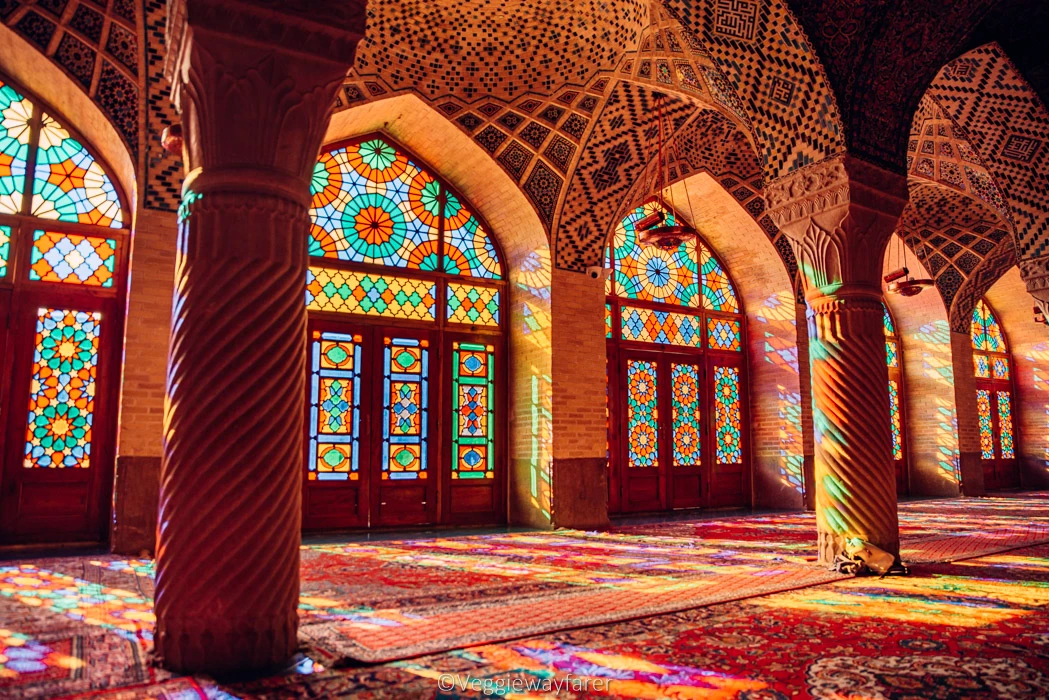
Day twelve-thirteen-fourteen in the Iran travel guide: Shiraz
Heralded for its wine (Shiraz wine originates from here…or it did, back in the day) a city of poetry, and let’s not forget fabulous pink tiles! It was the capital of Persia during the Zand dynasty (AD 1747–79) and many of its buildings are built in either Zand or Qajar dynasty (AD 1794 – 1925) architecture.
There are never enough days to explore the beauty of Shiraz. You could easily spend two weeks here and still be left wanting more. Walking around the streets of Shiraz (both modern-day and old town) was an absolute pleasure. The streets are clean, people are friendly and the monuments are worth every single penny. It was our last stop of the two-week trip through Iran and it felt bittersweet.
Our friends at TermehTravel decided to join us, which just added a sprinkle of something extra special to the city.
Read More: My in-depth 3-days in Shiraz guide
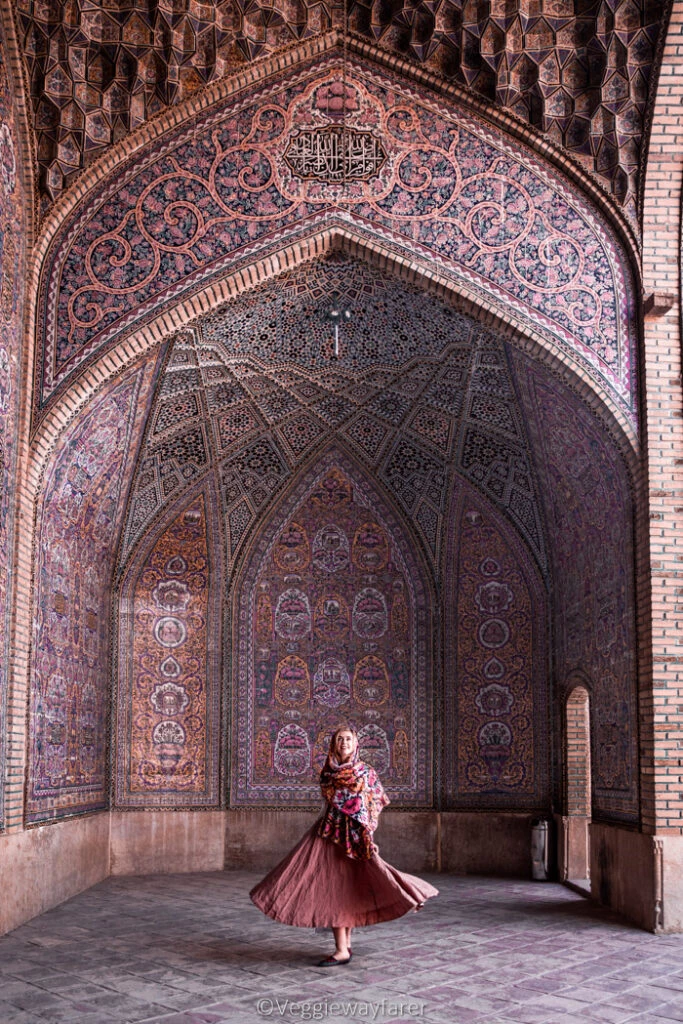

Free walking tour of Shiraz
Not sure where to start in Shiraz? This free walking tour has you covered. In two hours you see the main sights of the city including the Nasir Ol Mosque, The Vakhil Mosque and Bazaar and many more monuments. They run every day and are completely based upon tips.
Entrance fees to the monuments are not included and you need to register in advance. You can do so here.
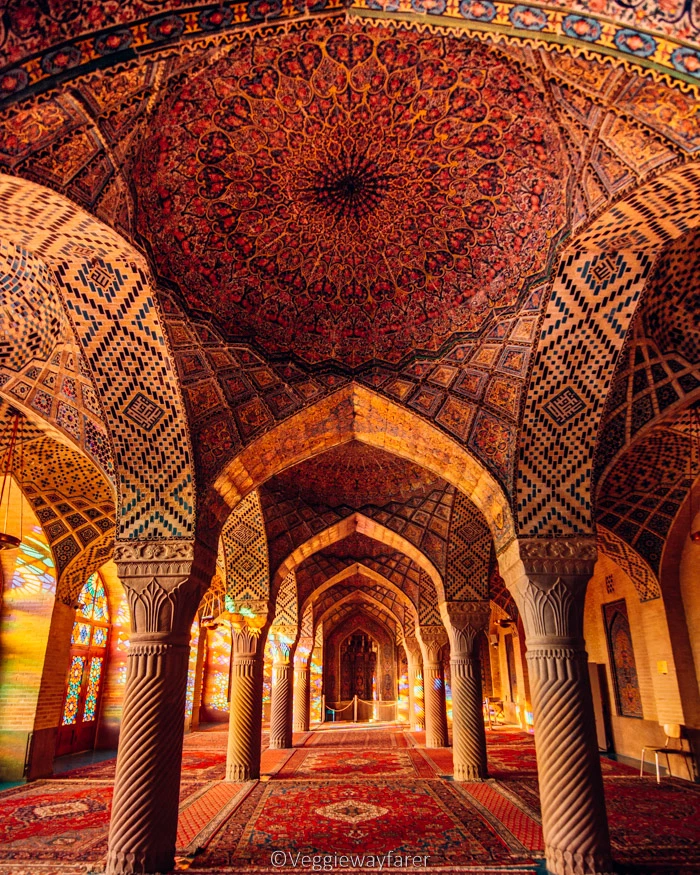

Nasir Ol Mosque: IRR500.000
The award for the prettiest mosque (probably in the world) very clearly goes to the Nasir Ol Mosque. It has 50 shades of pink and yellow tiles not to mention a winter prayer hall which will take your breath away. The light coming through the stained glass windows slowly spreads a rainbow’s worth of color across the floor and walls of the prayer hall.
The effect is at its highest during the winter months when the reflection covers all of the floor and bounces back off the opposite wall. It will feel like you have stepped into a kaleidoscope. This mosque is at the top of many people’s list of places to visit in Iran and gets very packed. Be sure to arrive early and enjoy all this mosque has to offer.
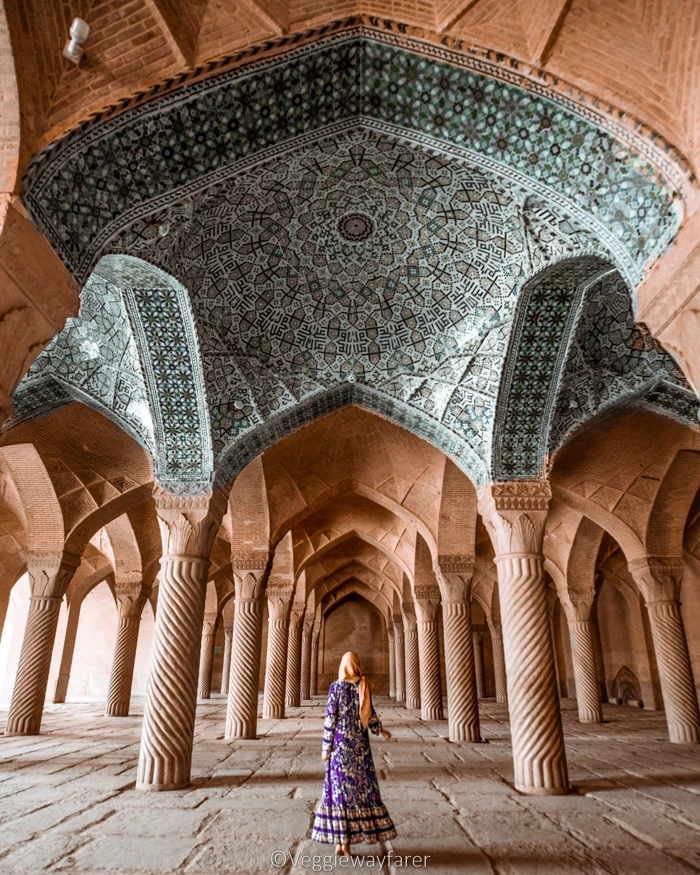

Vakhil Mosque: IRR500.000
A beautiful example of less is more. While the entrance is ornately decorated with vibrant pink tiles, the inside is a lot more minimalist compared to the vast majority of mosques in Iran. It was built during the Zand dynasty (18th century) and extensively renovated during the Qajar era (19th century) which explains the many floral tiles.
Floral motifs on the tiles were the height of fashion during Qajar rule! My favorite part was the prayer hall, directly opposite the entranceway. It contains the night prayer hall (Shabestan) which is made up of 48 perfectly geometrical pillars. The pillars are all carved by hand and depict a spiral motion.
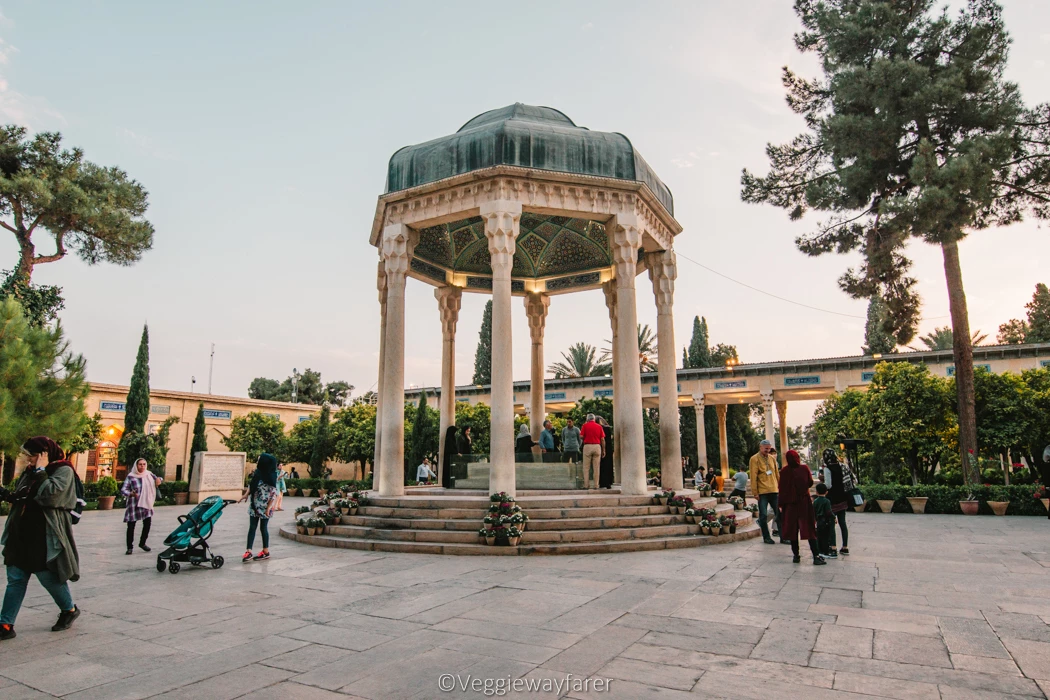
Tomb of Hafez: IRR500.000
Hafez is to this day still the most famous poet of Iran. From an outsider’s perspective, it almost feels empirical to read his poems to truly understand modern-day Iranian culture. His words permeate every layer of society and glue together both young and old. Therefore, it kind of speaks for itself that his tomb is one of those places you cannot miss out on when visiting Iran.
The entrance fee might feel rather hefty but it’s worth it in my opinion. At dusk, the grounds are filled with his fans who gather around the main monument often reciting his poems. It is one of Shiraz’s prime people-watching spots too. My advice is to pay the entrance fee, visit the monument and then park your butt on the steps opposite the monument and watch the people around you.
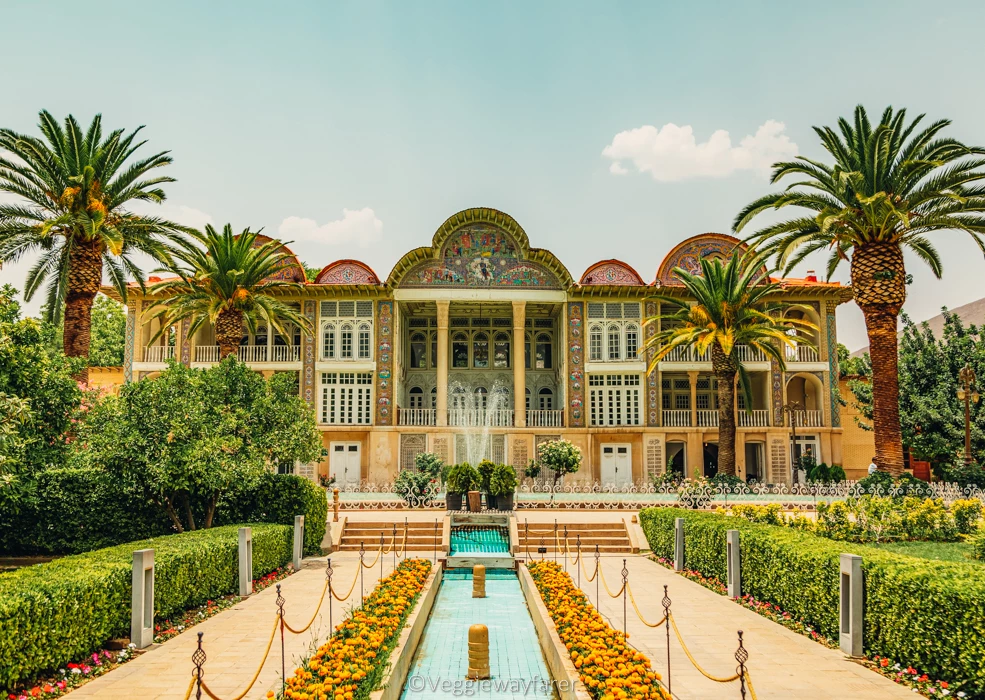
Eram Garden: IRR500.000
Speaking of people-watching spots, the Eram Garden will give the tomb of Hafez a run for its money. The garden itself is an example of a perfect Persian Garden: it has many water elements running through it and is built to geometrical perfection. The garden dates back to the 12th predating the house by about 6 centuries.
Now the real reason I liked this spot is because it seemed to be a very popular gathering place for the local youth. There are not many spots for young women and men to meet out in public. It’s just ” not done”, keep in mind the country is governed by Islamic law. This park however seems to be a little loophole in the otherwise strict system.
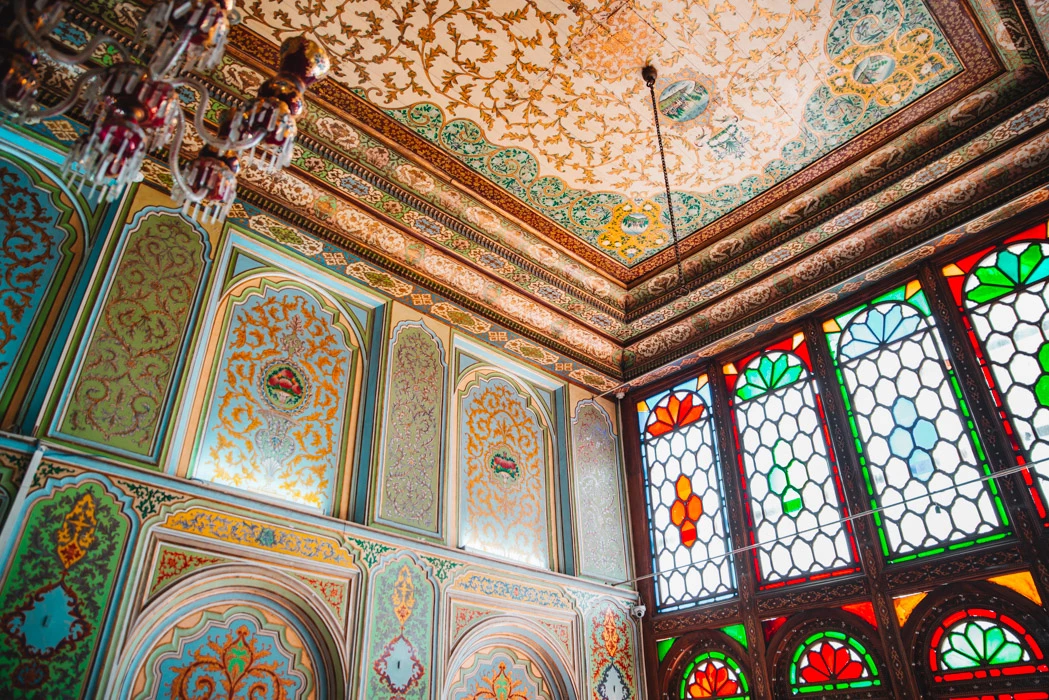
Qavam House: IRR200.000
Of all the Persian gardens we saw in Iran, this one was my absolute favorite. Smaller in size, but still containing all the elements that make up a Persian garden. It is locally known as Narenjestan because the garden is filled with sour orange trees, which are beautifully fragrant in springtime! The house was built in the Qajar dynasty (19th century) and until recently privately owned.
These days it belongs to the university of Shiraz and you can visit it and have a sneak peek into the living of the wealthy in the 20th century. It is one of those understated places to visit in Iran, or as some would call it a bit of a hidden gem.
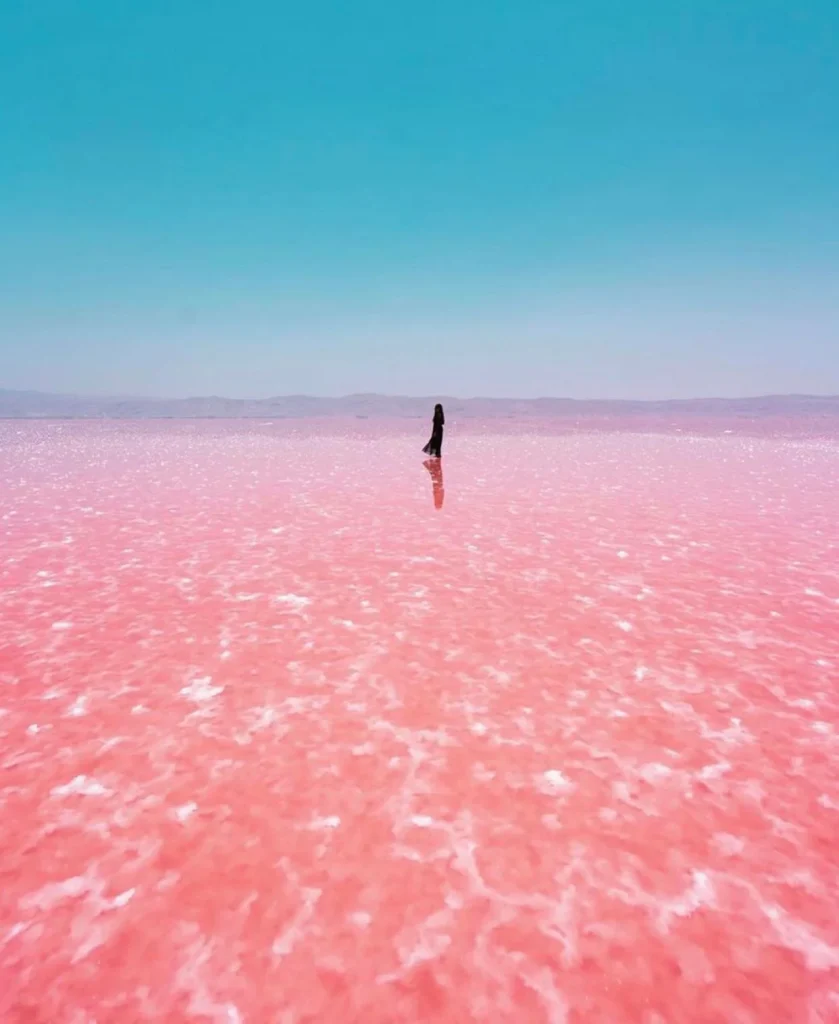

The Pink Lake (Maharloo Lake)
The pink lake is part of a seasonal river that dries up around the end of the summer and leaves behind salt sediment. Through natural processes, this sediment turns pink. Usually, this only lasts for a couple of weeks, but be sure to check with locals what the status is when you go. We went in October and it had only just dried up.
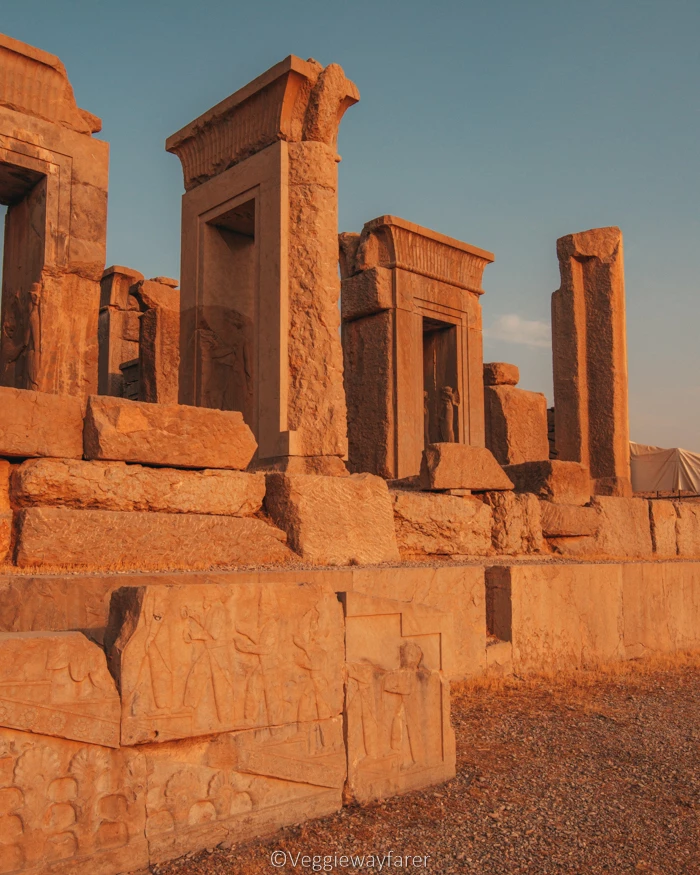

Persepolis: IRR500.000
This UNESCO-classified site is the ancient capital of the Achaemenid Empire (6th-3e century BC). It was burnt down by Alexander the Great which sparked a fierce hatred for this historical character, which can be felt to this day.
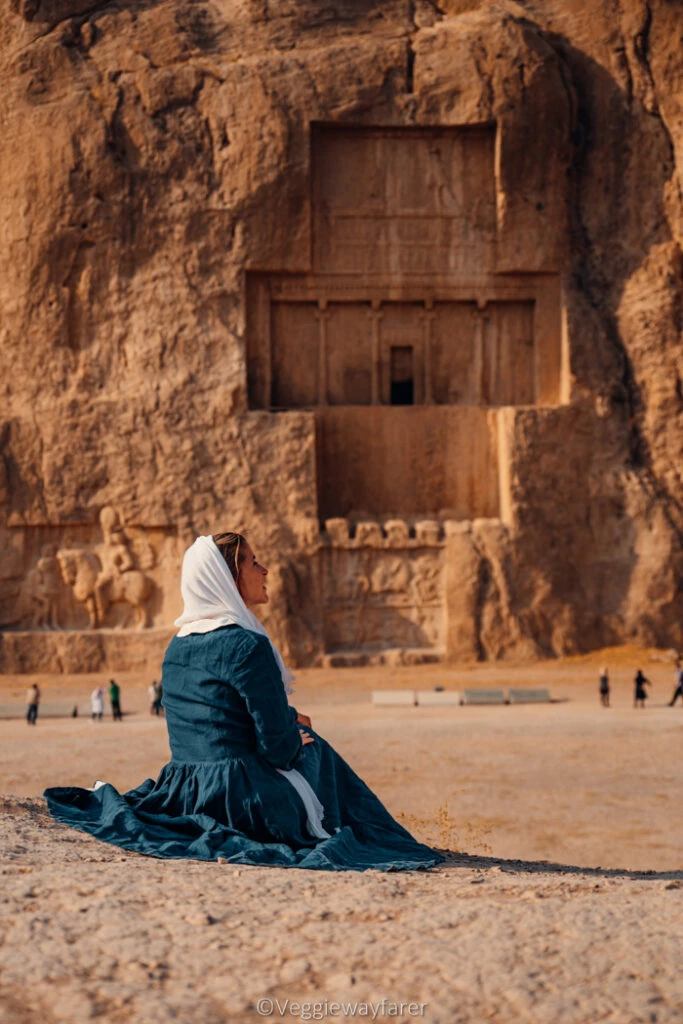

Naqsh-e Rostam: IRR500.00
A necropolis dating back to Achaemenid Empire. The burial sites were dug out of a cliff and are very impressive to witness.
Practical information to get to these sites:
How to get there: They are not accessible by public transport, so you will need to rent a taxi and/or guide for the day.
Price: For transfer and guide IRR9.070.000
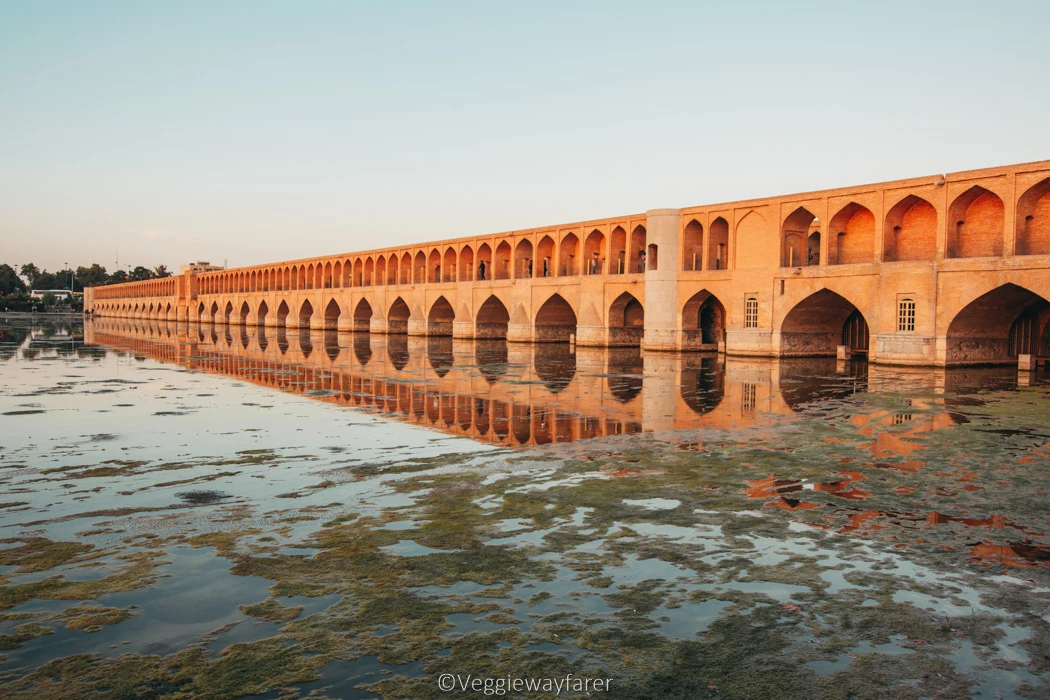
Etiquette to take into account on your Iran itinerary
The concept of Taarof
Taarof is the Persian (Iranian) art of etiquette. In no way do I pretend to understand the depths of this concept but I can provide you with a very top-line description, seen from an outsider (foreign perspective). Taarof will be felt in pretty much any conversation with an Iranian and it can be downright confusing if you do not know what is going on and worse you risk offending the person in front of you without having a clue what you did.
So let’s break it down. To put it very simplistically (and a bit crudely) Taarof is on the exaggerated form of politeness. A concrete example would be when you are invited to someone’s house. As custom dictates the host will provide food and beverages.
So far, nothing different versus the majority of Western cultures. However, the next part is a bit tricky: When you are offered food and drink politely decline. I hear you thinking “What? Now that is just rude!”. Actually, it’s not, it would be rude to accept according to the principle of Taarof. Your host will ask again, and you decline again. Go through these motions about three times and then finally you can accept the offer graciously.
Most likely you will also feel Taarof when going shopping, taking a taxi, or eating out in restaurants when you are told the items are “free of charge”. In fact, they are not, the person in front of you is being polite, Iranian polite that is. You will need to pay for whatever services you have used; you might just have to insist a couple of times before they accept.
Can I take pictures of religious buildings and people in Iran
While in most countries, tourists are sometimes looked down upon and locals will certainly not move out of the way for tourists taking pictures, I found the opposite to be true in Iran. I lost count of the number of times people thanked us profusely for visiting Iran and goodness gracious me, they would practically jump out of our way when we wanted to take a picture.
Invitations were handed out left and right for us to come to people’s homes and to dine with their families, not to mention to overwhelming responses to our stories on social media. I would have loved to be able to say more than ‘Mamnoon’ (thank you) when conversing with people and vowed to learn Persian for my next trip.
Note: Places of worship such as shrines usually ask tourists to refrain from taking pictures with their professional equipment. Phone photography is allowed, albeit in a discreet manner without flash.

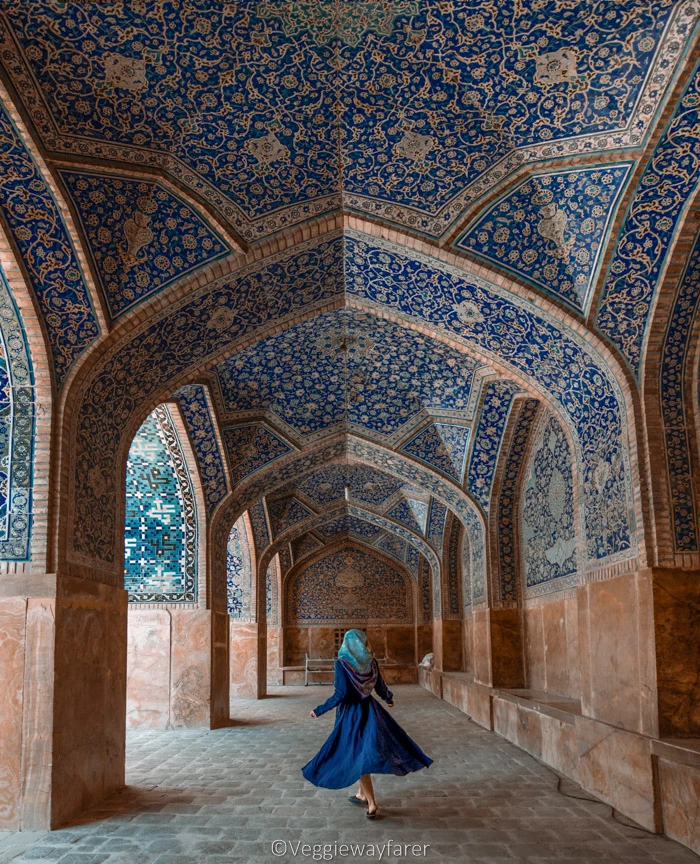
What to wear as a woman traveling to Iran
This is something I struggled with the most when planning my trip. You will need to ‘cover up’ when traveling to Iran as a woman. Do not worry, there is room for interpretation when it comes to covering up in Iran. As a general rule of thumb, dress modestly – no cleavage, tight-fitting clothes, or short clothing.
When you are in public and religious places you absolutely need to adhere to these rules. If you are invited to the home of other people, or inside a restaurant it is best to check what the local women are doing and follow their lead. When in doubt, just ask!
When you are in public and religious places you absolutely need to adhere to these rules. If you are invited to the home of other people, or inside a restaurant it is best to check what the local women are doing and follow their lead. When in doubt, just ask!
Head: This needs to be covered with a loose shawl.
There are two distinct headdresses to take into account in Iran. The first one is a Hijab, which is a scarf that you loosely drape across your head. The other is Chador, which is required in certain mosques. It is a long piece of cloth that covers your head and the majority of your body.
Arms: Please cover up until just under your elbows.
Legs: Need to be covered until the middle of the calves. You can wear jeans or leggings but just make sure that your butt is covered with a long jacket.
Shoes: Anything you fancy.
Tip: it is best to carry a scarf with you on the plane as you will be required to cover your head before stepping out of the plane and onto Iranian soil.
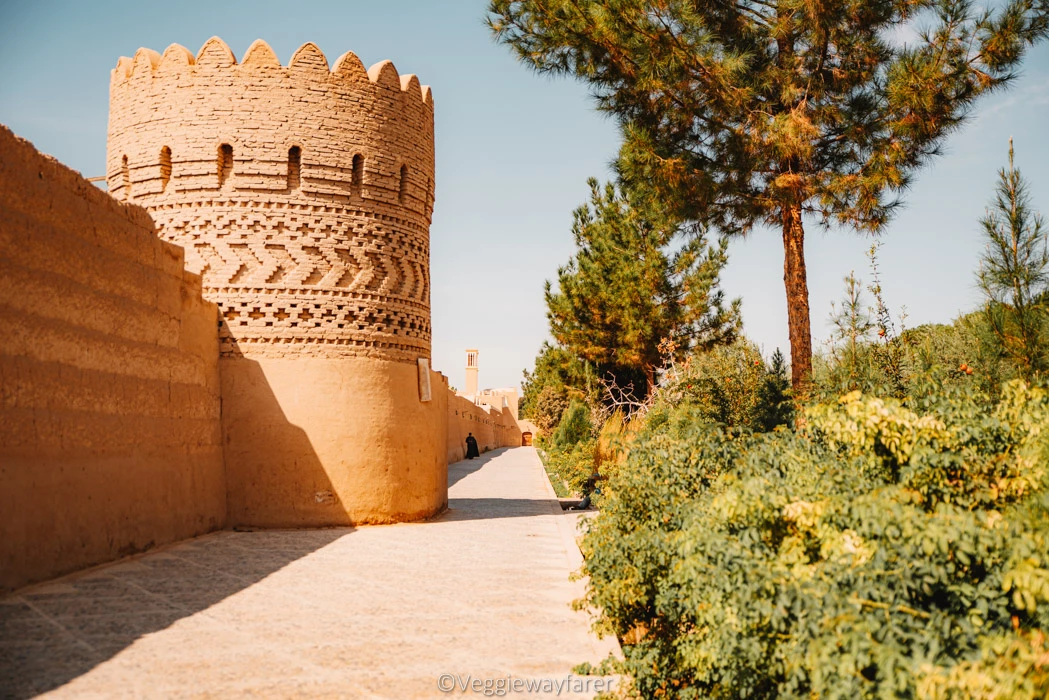
Practical details for your trip to Iran
Currency
The official Iranian currency is Iranian Rials (IRR). However, locals much prefer to use the word Toman. Keep in mind that 1 Toman is 10 Rial, and be sure to always double-check if the price is in Rials or Tomans.
Visa Requirements:
There are only about 8 countries in the world that can travel to Iran without a visa.
For all the rest of us, there are two options:
OPTION ONE VISA UPON ARRIVAL
Be sure to check if you are eligible for a visa upon arrival (VOA) because not every country can use this option. Have a check here
What do you need?
A passport that is valid for at least another 6 months, 2 passport pictures, preferably a return ticket, valid travel insurance that also covers Iran, an invitation letter (tourist agency, hotel, friend), and enough cash to pay for the visa fee.
Where can you receive this Visa?
You can only get a visa upon arrival at the major national airports and not if you are traveling overland! Check if you are coming in through any of these airports:
IKA: Imam Khomeini Airport
TEH: Tehran Mehrabad Airport
SYZ: Shiraz International Airport
MHD: Mashhad International Airport
TBZ: Tabriz International Airport
ISF: Isfahan International Airport
KIH: Kish International Airport
OPTION TWO: GET YOUR VISA IN ADVANCE (E-VISA)
I used this option for peace of mind. The team behind TermehTravel helped me out and I had my visa within 24 hours.
You receive an email with a code, which you print and take with you. When entering the country, you present the border control with this paper and your passport and you can enter. I was very surprised not to receive a stamp on my passport. In fact, there is no proof in my passport at all that I actually entered the country.
Cost of the visa: $50
Documents needed: Passport valid for at least 6 months, travel insurance, invitation letter
Visiting Iran as a vegetarian
Iran is a country that loves meat in any which form. The traditional Iranian restaurants outside of Iran do not serve many vegetarian options. I was a bit worried about finding vegetarian options. Turns out, these worries were for naught. I am in the process of writing a dedicated blog post on the vegetarian food you must try in Iran. Stay tuned!
Restricted Internet in Iran
Certain apps (Facebook) and content on the internet (various Google functions) are blocked so my advice would be to invest in a good VPN before going.
Iranian Toilets:
In Iran, it is customary to use water to clean oneself after going to the toilet and not toilet paper. Most places will have a little paper available (to dry yourself off). If you want to be absolutely sure, take paper with you. Make sure to throw the paper in the waste bin and not the toilet itself. Speaking of the toilet, many places have a traditional toilet which is a squat toilet and not a seating toilet.
Ordering food in local restaurants
Many restaurants, bars, and even historical sites have websites that are solely in Persian. This means that planning anything usually takes a bit more effort, but that is part of the adventure! Luckily enough, there is a simple way around this problem in the form of an unlikely ally – Instagram.
Iranians absolutely love Instagram, it is a platform that is not blocked by the government (for now) and thus widely used by everyone and their cat. Before despairing over not speaking Persian, try and pop onto Instagram and see if the place you want to visit has an account. I bet they do and are actively managing this account. Send them a DM with your questions and you should have an answer pretty quickly.
ADDITIONAL RESOURCES FOR TRAVELING TO ASIA & THE MIDDLE EAST
Things to do in Shiraz, Iran
Guide to two days in Bukhara
The perfect guide to things to do in Samarkand

Two weeks in Iran Travel Guide: Pin It
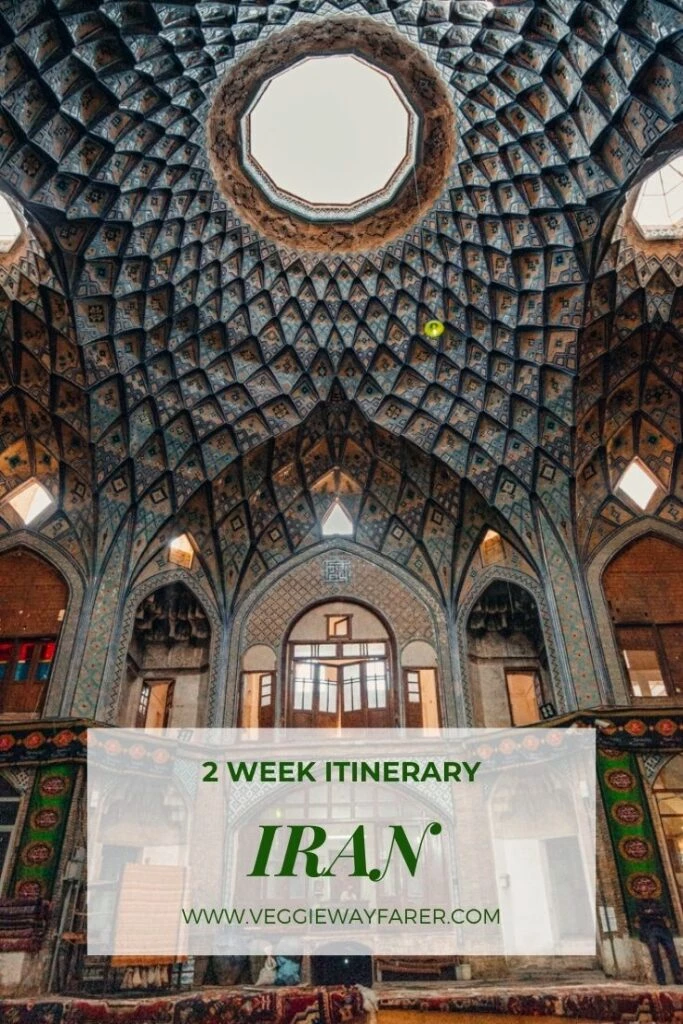

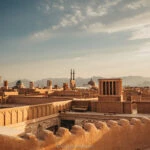



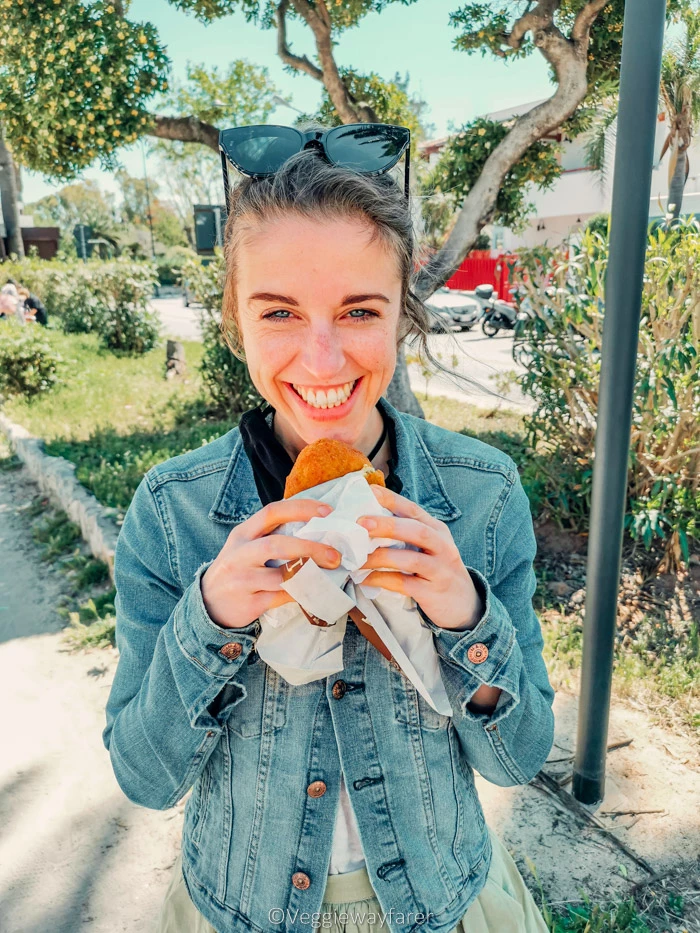
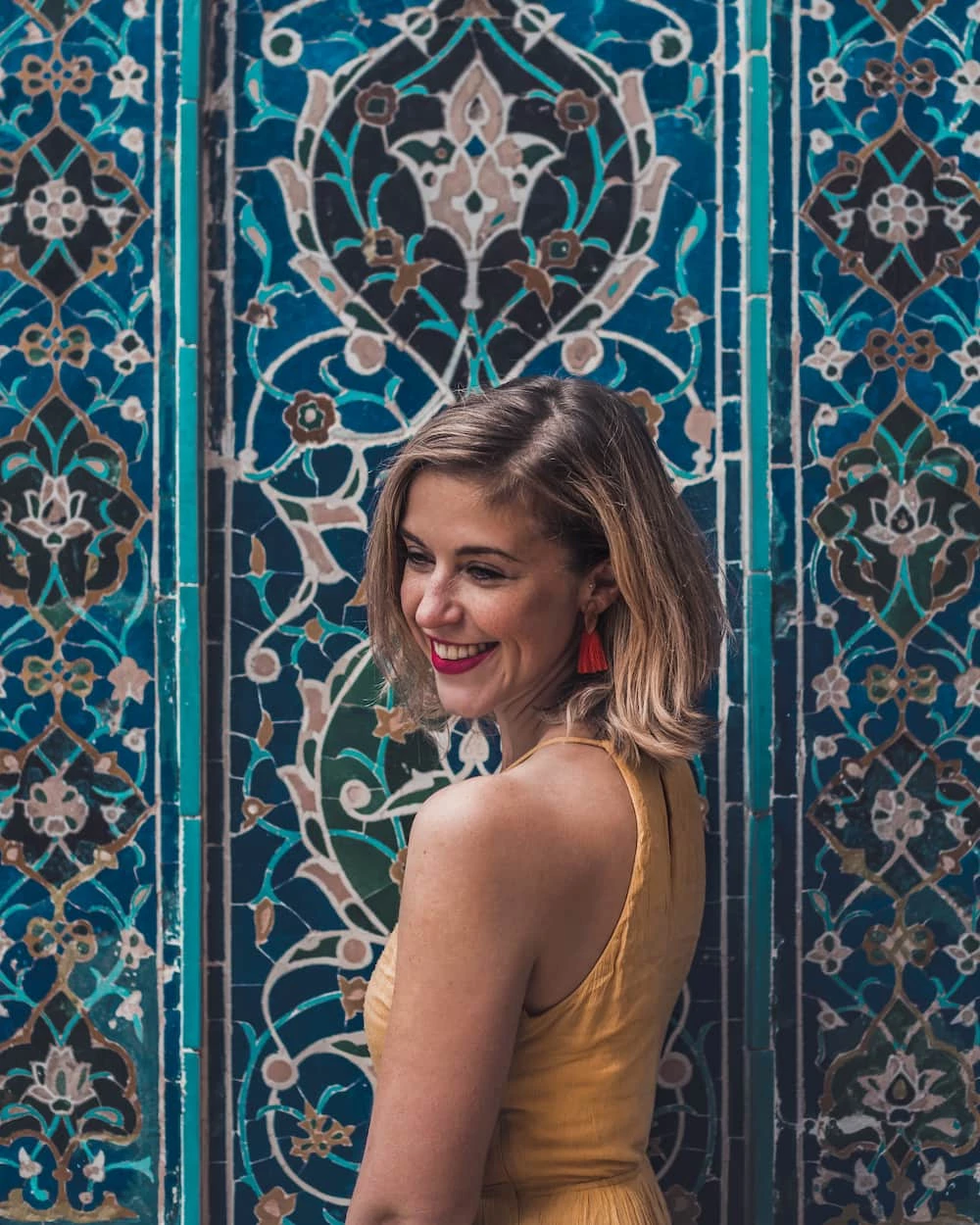
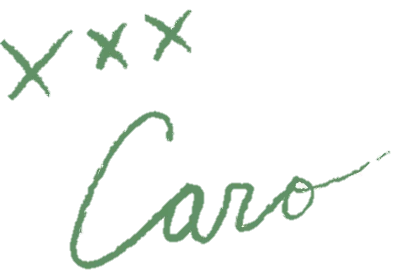
You had an amazing trip, and thanks for sharing these details. I’m looking forward to your Iran travel for vegetarians blog. I should strat follow your blog for other travel ideas, too.